Here is a 25 minute video of our backcountry adventure around Tombstone Territorial Park, YT.
Thank you for watching!
Our adventures around the world…
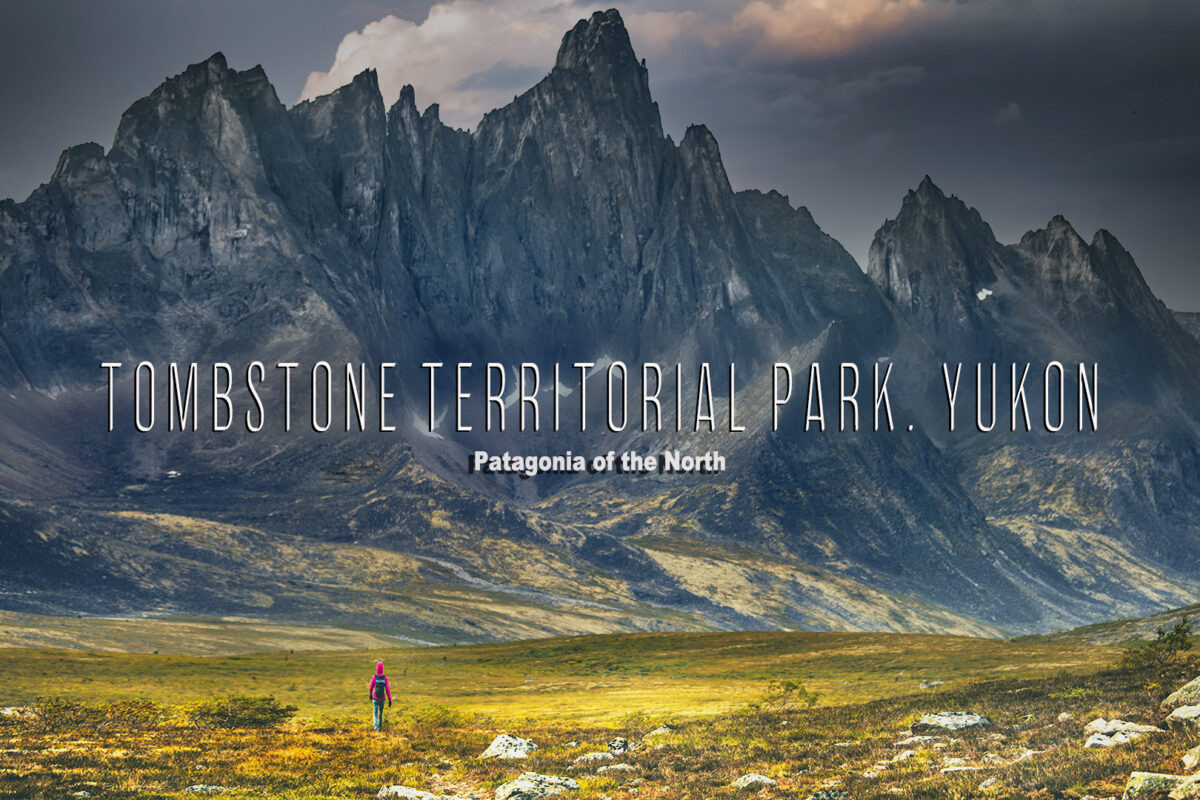
Here is a 25 minute video of our backcountry adventure around Tombstone Territorial Park, YT.
Thank you for watching!
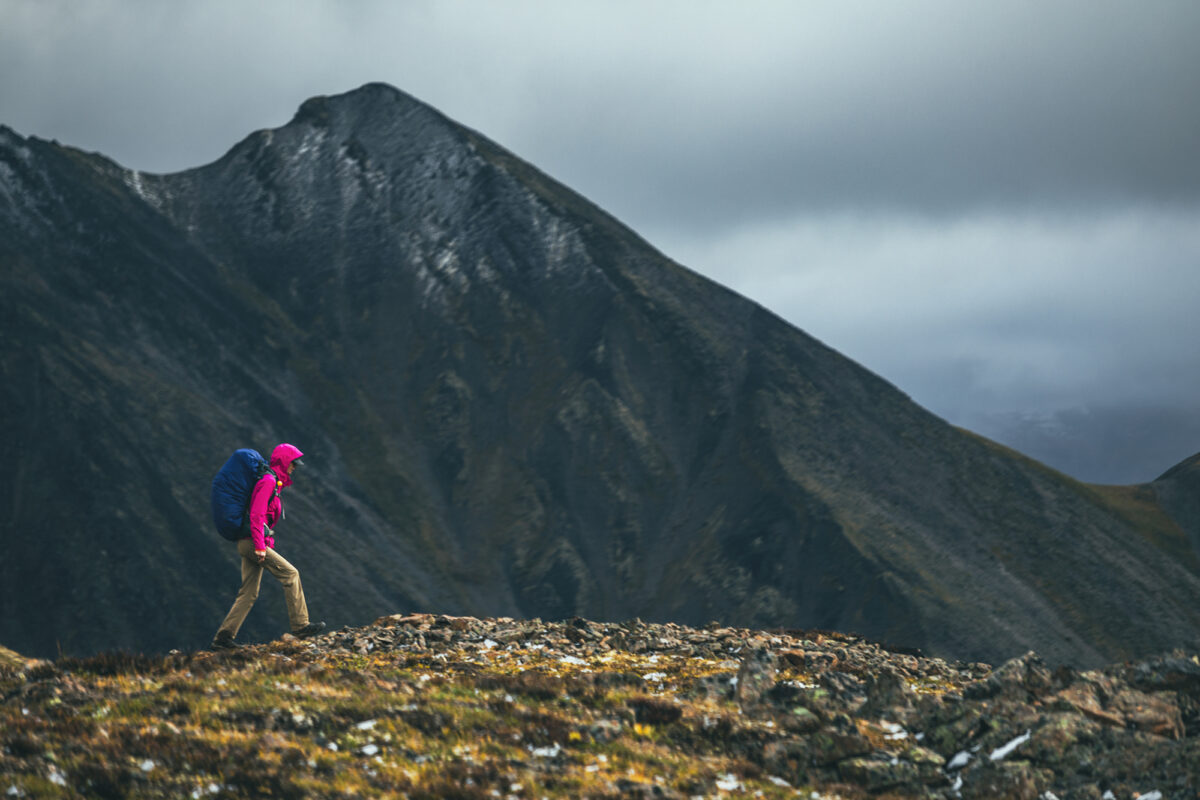
When I had looked at the forecast ahead of starting the trek, I saw that rain was to be expected on this day. The forecast had been very accurate so far, so I definitely prepared myself for a wet day, hiking back over the Divide pass. At breakfast we chatted with a couple who had crossed from Grizzly that morning, hiking the pass before the rain started. They were going all the way to Talus, and taking a snack break at Divide Lake.
It only took us about 4 hours to hike from Grizzly to Divide on day 2, so we really didn’t have to rush out first thing, and decided to take our time in the morning (although we missed the window of no rain, but that would have been quite an early wake up, which we’re admittedly not the best at). Packing up a tent in the rain is a bit of a process, but we took our time and put the tent in a waterproof bag so it wouldn’t get the rest of our stuff wet in the backpack. At breakfast I made sure to eat enough to avoid feeling low energy like the previous day. We had also planned a few energy bars for the way. I knew having a Naakbar just before starting the climb would help a lot.
Once everything was packed up, we headed out in the rain. We covered the first 4km around the mountain pretty quickly, and had our snack at the bottom of the climb as planned. Brice had told me the day before that if I recorded videos with my phone, he could use them, along with his to make short movie about the trek. So I spent a good portion of the climb making little video clips. It ended up being somewhat entertaining and possibly made the way up a bit easier.
Although to be honest I didn’t find it as challenging as I thought it might be, probably thanks to proper fueling + mental prep. We didn’t hang out too much at the top as it was pretty windy, but turns out the rain had pretty much stopped while we were climbing. I think it only picked up after we started going down.
I was slightly more anxious about the way down, as you walk down muddy trail across a grassy area – all made very slippery with rain (hence the name “Glissade” I guess, which more or less means slip-and-slide in French)
I was pretty cautious going down and was hoping that even without poles it wouldn’t be too slip-slidy, and in the end it wasn’t so bad. Once we were down it was less than 1km to get to the campground. In the end it only took is about 3 hours to hike the 6km this way (vs 4 hours on the way in).
It was still raining when we set up, which also made it a process, but eventually our tent was up, pretty much dry on the inside, and we headed to the cooking tents for the “goûter” (afternoon snack). Then another rest time in the tent before going back out for dinner. I would say the trek was definitely worth it even with mixed weather, the main drawback being that we spent our “rest time” tucked away in the tent to stay warm and dry, while with better weather we might have hung out by the lakes more, or explored the area near the campgrounds – unless, on the flip side warmer weather would have meant hordes of mosquitoes which could be equally as deterring from being outside. At dinner we shared a table with a group of hikers from Whitehorse, who were doing the trek for the first time after a couple of unsuccessful attempts in the past due to weather.
As a side note, I was pretty delighted with our dehydrated meals. We had a selection of Backcountry Pantry, AlpineAire and Happy Yak, and all were very tasty (all around 600 or 700 calories per serving). Outside of meals and energy bars, we had also bought some treats like mini Toblerone and almond/cashew nuts. I wish I’d brought tea and a few more treat choices, always welcome especially when fighting the cold, but ultimately a we did fine.
One more night before heading out. I finished the book I had started on the first night: “Split Tooth”, by Inuit author Tanya Tagaq, a mix of auto-biographical, poetic, mystical- filled novel about a young girl in Nunavut. It was a pretty good match for the dramatic, cold setting we were in, and a captivating read, actually hard to put down. Although a book is added weight, I wasn’t sorry I brought it along, especially given the time we spent in the tent, hiding from the rain.
It got pretty cold that night, and we woke up to a dusting of snow on the peaks around us.
We made sure once again to have a good breakfast, including a tasty couscous dehydrated meal (1 portion shared), to get us ready for the 12km hike out.
The tent was wet and our pants were pretty muddy but I still had dry pants, socks and gloves so the day started well. We packed everything and set off for the hike out. When leaving Grizzly lake, there’s a creek crossing that isn’t insignificant. Not deep but rocks are spread out enough that it can be a bit tricky to hop from one to the next. We had gone through it 3 times already without a hitch, but this time, I slipped on a rock and ended up with a leg in the water up to my knee – not ideal in near freezing weather.
Thankfully, my goretex shoes kept most of my foot dry, and somehow, my pants repelled most of the water and my long-johns underneath were quick to dry. I still took a moment to change sock and threw a toe warmer in my shoe to avoid any toes going numb. Sadly my gloves were soaked and I didn’t have another dry pair (I did bring 2 pairs. but the first one was a already wet from the previous day’s hike in the rain. Note to self: next time, bring three pairs). So I resorted to hiking sans gloves, which ended up being fine as the temperature warmed up slightly throughout the day.
We had 12 km to hike back to the parking lot, with the first 7 or 8 a slow incline towards the ridge – We didn’t have much views on the way in on day 1, but the sky was much clearer on the hike out, and we were able to appreciate the views from the ridge, including looking back at Grizzly Lake, which could be seen quite clearly from most of the ridge.
We caught up with Kendra & her mom somewhere along the climb. They were still in good spirit as we said goodbye to them.
The portion on the ridge was quite windy, but warmer than down below so it was a bit tricky to know what layers to keep or remove.
We made couple of stops for snacks and eventually started descending back into the trees. The downhill wasn’t bad, but the last section, relatively flat in the forest, seemed to go on forever, I didn’t remember it being so long but again that was at the very start, on fresh legs.
Finally we made it to the car, all muddy and sweaty from the last section, but pretty pleased to be done. We changed to less muddy clothes and shoes and drove to the visitor center to return the bear cans, then we had to drive the 1.5 hours back to Dawson city.
I was hoping we could find a motel room to spend a night in and have a warm shower. But as we soon found out when we got into town, it was Saturday night and everything was booked. I got a bit annoyed as we’d almost booked a room for that night when we registered for the backcountry trip, but decided against it for some reason I couldn’t remember now.
We drove to a couple of RV parks and landed at the Bonanza Gold Motel and RV park, just outside of town.
Although it wasn’t very glamorous (the tenting area was on gravel near the road), it had showers and laundry. I was still intent on having a night in a bed, and I managed to book a room in the motel for the following night.

Our towels were soaked from drying our gear while in Tombstone, but we were able to rent a couple of towels from the motel office. They were surprisingly nice towels, all warm and fluffy, probably just out of the dryer, and that instantly made me feel way better.
Showers were $1 for 2 minutes. I put in $4 dollars, but 8 min ended up being quite a bit more than I needed. Still it was soooo nice to have a hot shower after 5 days of rain, cold, faint sunshine and more rain.
Once we were all cleaned up we headed to town for dinner. Weirdly, despite all the hotels being full, most restaurants were closed. We came to realize that opening hours in Dawson City were to be taken with a grain of salt, as, in the days and a half that we were there, we came across a few “Sorry we’re closed today” hand-written notes on doors. That night we ended up at the Sourdough lounge, adjacent to the Downtown Hotel, and had post-trek celebratory burgers and fries.
We’d been told that Dawson City had quite the nightlife, but for a Saturday night it seemed pretty tame (although we didn’t venture to the local casino, Diamond Tooth Gertie’s, famous for it’s nightly French Can Can Show). It’s possible the town was still recovering from it’s annual 3-day Discovery Days festival the week before, which apparently is pretty rowdy according to the two of Quebecois guys we’d met while in Tombstone. After dinner we went back to the campground and Brice took advantage of the late daylight to tidy up and reset all the hiking gear, food, etc. while I sat in the tent and finished writing up the tale of our five days of trekking.
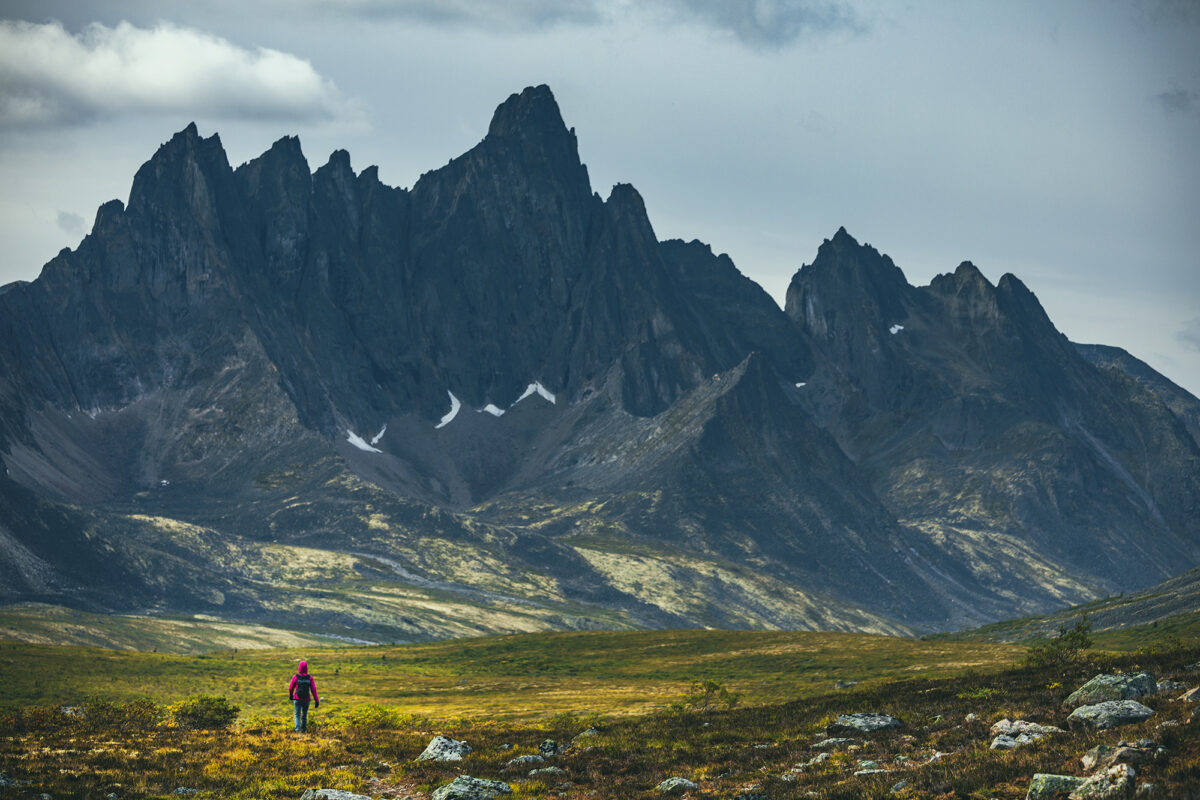
On our third day in Tombstone Territorial Park, we had planned return trip to Talus Lake, from Divide Lake.
As we had already experienced, the weather forecast had been pretty accurate so far, and it didn’t let us down on our third day, when the predicted clear and sunny day turned out to be true. The plan was to hike out to Talus lake and back, for a total of 12km with minimal elevation. There’s a campground at Talus Lake so people do camp there, oftentimes going straight from Grizzly without stopping at Divide for the night. But we liked the idea of having a backpack-free day, and not have to move camp. We chatted with Kendra and her mom again at breakfast. They were taking advantage of the sunny and dry weather to go over the pass and to Grizzly lake. After breakfast we headed out with our light day packs.
After circumventing the lake, the trail climbs very slightly onto a broader plateau, then meanders through the tundra all the way to Talus lake. We realized the range we were looking at from Divide was really the back side of the range overlooking Grizzly lake.
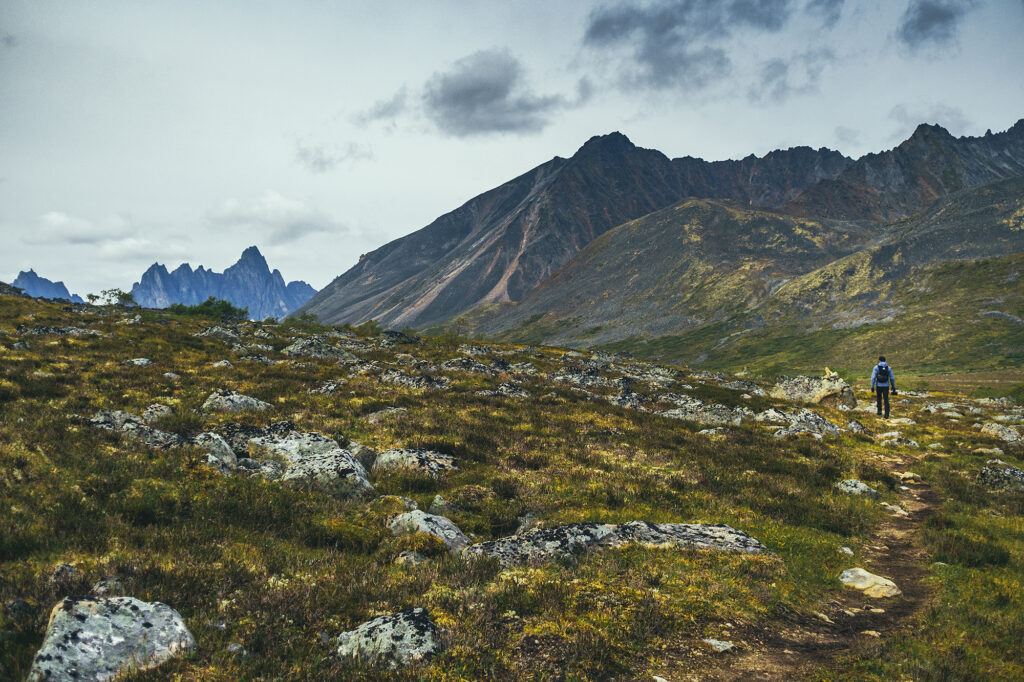

Talus lake was once again very scenic, similar jagged peaks of Tombstone Mountain spreading as a backdrop to the arid, low growing tundra, possibly even more dramatic than the previous two lakes. We had lunch at the lake under the cooking tent. It was sunny but still pretty cold. We had brought a proper dehydrated meal as opposed to only energy bars, as well as coffee to warm up.
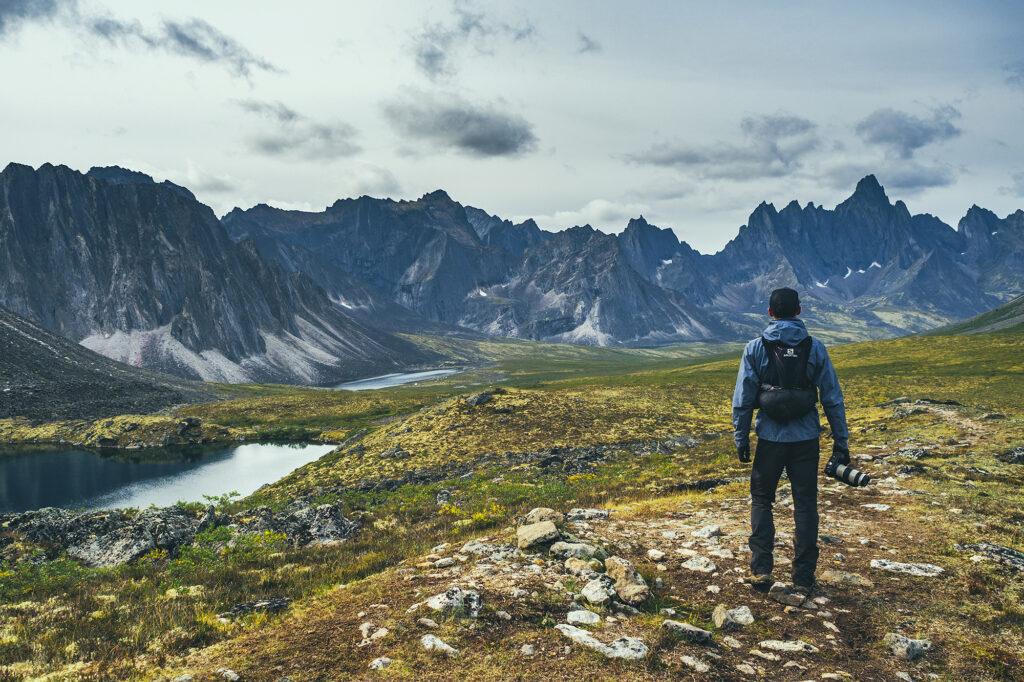
I was actually feeling pretty low energy that day, not sure if it was from insufficient caloric intake, or a result of the previous two hiking days. With the cold, and being quite sensitive to it myself, it did feel like I was burning a lot of calories just to keep warm.

After lunch we explored around the lake a bit then headed back. It was a nice relaxing, easy hike and I was glad we did it pack-free for an easy but still scenic rest day.
That night at dinner we chatted with a couple who had arrived at Divide that day and was planning to do the same thing we did the next day. We also saw a ranger, who had hiked all the way from the start and was pushing to Talus that same day. I guess they’re pretty used to doing the 24km circuit in one go.
It probably wouldn’t be impossible for us either, if we carried a smaller pack and much lighter camping gear.
The ranger asked to check our reservation, which we were both surprised and ultimately glad about – wasn’t expecting a check that far into the route, but at the same time it reaffirmed that we were right to book ahead and properly register.
I’m sure some people might just wing it without a permit, but you then take the chance of not having a proper tent pad (resulting in camping on and damaging delicate ground), or taking one from someone who did pay, which would obviously be very uncool. Ultimately it seemed like Grizzly lake was the busier campground (when we were there anyways), as people may only come for 1 overnight, or decide to turn around and not continue on if the weather isn’t ideal.
The park doesn’t actually allow booking a site at Divide Lake as the first night – you have to book Grizzly Lake before you can book any other sites. This, I imagine is probably due to people in the past underestimating how challenging those 18km actually are to complete in 1 day, and ending up stopping at Grizzly Lake instead, overcrowding that campground as a result.
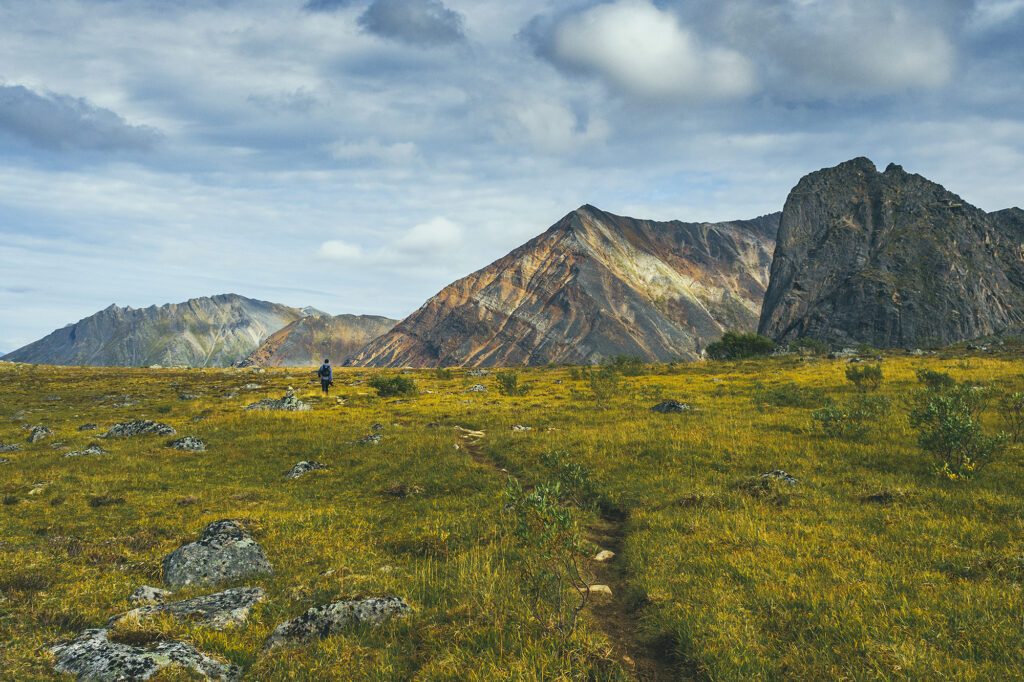
Of course some people would be able to hike in further and bypass the registration system, but that’s at the risk of impacting other hikers and/or the fragile environment. In addition, if you have any problems out there, the park doesn’t take any responsibility to get you out, so it’s best to have your own rescue plan, i.e , leave your trip plan with a friend and ask them to alert the RCMP if you don’t come back when expected.
There is no signal in the park and Satellite is apparently unreliable (we didn’t have an in-reach so we couldn’t confirm).
So bottom line is, despite this being a popular route, there are challenging areas where you might find yourself on your own, so always go out prepared and make sure to communicate your plan in case anything goes wrong.
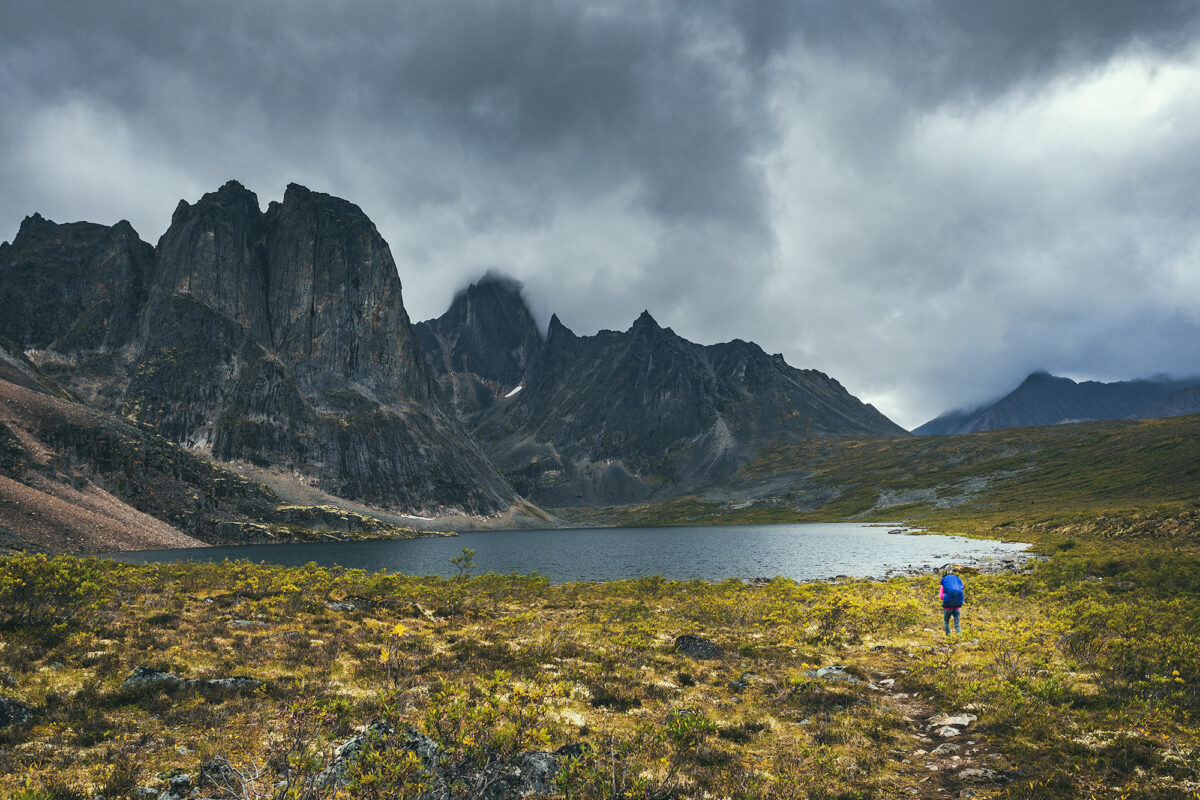
In August of 2021, we drove more than 9000 km from Vancouver, BC to The Yukon and back. One of the highlights of our road trip was a 5-day backcountry trek in Tombstone Territorial Park.
Tombstone territorial Park is a 2200 square kilometre area of protected wilderness, offering stunning views of tundra landscape, incredibly rugged peaks, and home to abundant wildlife. The park lies within the Traditional Territory of the Tr’ondëk Hwëch’in First nation and is a legacy of the Land Claim Agreement. It is managed in collaboration between the territorial government and the Tr’ondëk Hwëch’in First nation, with particular efforts on protection and preservation.
The park offers a wide range of hiking opportunities, including a 48km out-and-back backcountry circuit.
Dawson City
We got to Dawson City a bit after 3pm, and quickly looked for an outdoor gear place, after realizing that our small backpacking stove was out of commission – not ideal since we were about to head off for 5 days in the backcountry.
We found what we needed at the Trading Post, a neat shop that sells modern outdoor gear as well as a bunch of antique ones. It’s one of those stores that make you want to buy everything! I also bought a small sewing kit to fix up a hole in one of my gloves.
After that we headed to the airbnb booked for the right, a good way to comfortably reset and get our backpacking stuff ready for the next 5 days of t hiking and backcountry camping.
One thing we hadn’t quite sorted before arriving were bear canisters. They are required to go into Tombstone, to protect both the wildlife and people. We hadn’t bought or rented any as I had read somewhere that the park could lend us some, for a $60 deposit.
As I did a final check on the park website, I got a bit nervous as about being able to indeed borrow them so I ended up calling the Interpretive Center minutes before it closed at 5pm, and the confirmed that although they no longer rented them, they still had some on hand to lend. The park is quite far from Dawson so I guess they would still prefer people go in with the proper bear safety equipment than go without. There wasn’t really anywhere else to find bear canister in and around Dawson City. I don’t actually think the Trading Post sold them (but maybe they do) and the only possible rental was with the local adventure guides in town, but they wouldn’t open until 10am the next day – too late for us as we were headed to Tombstone at 7:30.
We had already purchased a number of dehydrated meals, so we put them and all other energy bars and snacks in ziploc bags, as was suggested in the park guidelines, to contain food smell as much as possible.
Once we were relatively ready for the next day, we went out to try and find a place to eat. At 9pm on a Monday, the only place we found open was the Drunken Goat and that night they appeared to be making pizza only – which we didn’t mind. It took 45 min to get our food, (we had been warned by the waitress from the get go, but there weren’t many other restaurant options). In the end the pizzas were pretty substantial and we took left overs home with us.
There is a 1.5 hour drive from Dawson City to the Tombstone Interpretive center, which is actually 20km past the trail head for the backcountry circuit. We left around 8am and were there at 9:30am to collect a couple of bear canister in exchange for a cash deposit. In hindsight, although convenient when you show up without them, I would probably acquire bear cans before hand, as the only reason we drove to the center was to pick them up and return them – which also meant we had to be back before 5 pm on our last day, otherwise taking the risk of having to camp at the front country site and return them in the morning.
In any case, by 10am we were at the trail head and we organized all the food into the two cans. They seemed pretty full but we might have been able to squeeze in a few extra snacks, I know I felt like I could have had more food during the 5 days, but of course that would also mean more weight. In the end we did alright with enough trail food, afternoon snacks and a couple extra lunch packs to complement protein and energy bars during the day. We had an assortment of dehydrated meals from several brands, which all turned out to be tasty very (especially so after hiking in the rain!)
The first day involved a 12km hike in to Grizzly lake, with 750m of elevation gain. The first 2.3 km were on a relatively flat single track trail, albeit very muddy and with lots of roots and rocks. Then we left the trees and started climbing to the ridge on exposed terrain, which was probably the most challenging part. It was rainy and windy, with zero visibility and for a moment I thought “what the hell are we doing, is it going to be miserable this way the whole time?”. But then I literally had another moment when I thought “Well, I could be grumpy the whole way, or I could NOT be grumpy the whole way” and just like that my mood changed. We stopped at some point, about 4km in, as we were both feeling the ass-kicking from that climb. and had a Naak bar to boost us up (which, as always, it did).
The trail continued to climb more gradually along the slope, just below the ridge, and eventually we started to descend into the valley. The lower part of the trail wasn’t necessarily easier, it even got a bit more technical with rocky areas to cross at regular interval, and not a lot of smooth ground. Eventually though we made it to the campground, which, on a clear day, can actually be seen from quite a distance.
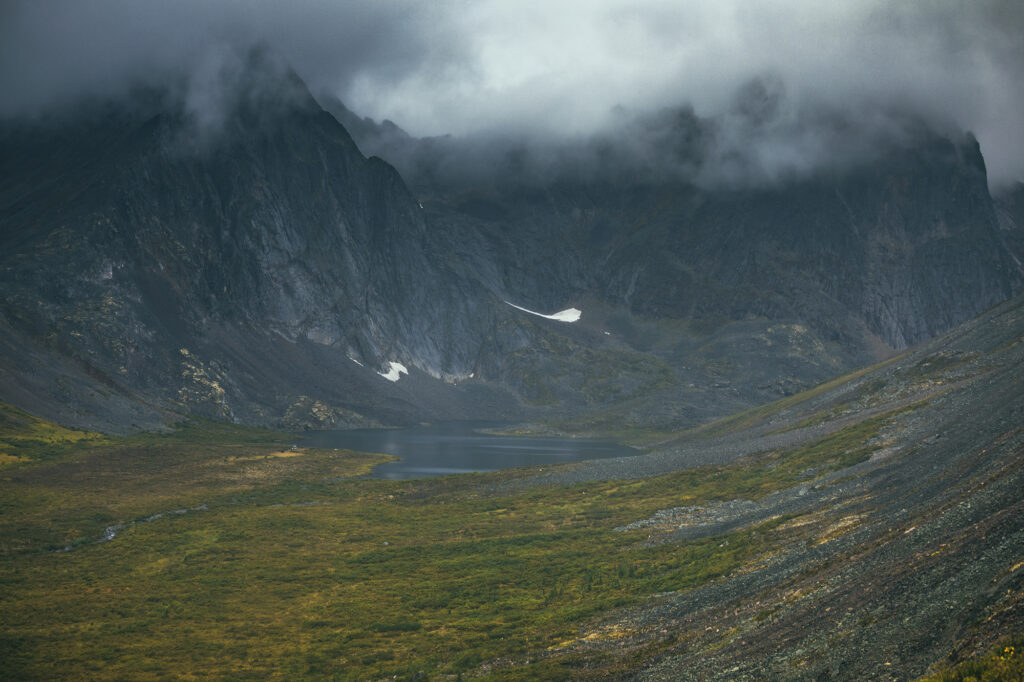
The campground was set up with a dozen or so tent pads along a well defined trail. Setting up a tent anywhere else is prohibited, as the ground is covered in very delicate tundra vegetation, moss and shrubs that take a long time to grow in this harsh environment.
The tent pads are some distance from the lake, and the trail continues down to its shore, passing a couple of outhouses on the way. The cooking tables and tents are set up near the lake, along with bear caches. All food must be prepared there, and stored in the caches, to avoid attracting animals and especially bears, to the sleeping areas.
The cooking tents were pretty convenient shelters from the rain and provided good opportunity to chat with other hikers. We had a snack and got our tent set up. Since the weather was still pretty cold and wet, we tuckered in with a book until dinner time.
At dinner we chatted with two twenty-something guys from Quebec, who were planning on hiking to Talus lakes the next day (passing through Divide lake) to spend the night.
After dinner there wasn’t much to do other than go back to the tent and read for a bit, so we were pretty much in bed by 9pm. It rained overnight, but stopped in the morning.
Second leg of the circuit, we hiked to Divide lake via Glissade Pass. The pass is only about 1km from Grizzly lake, but has an elevation gain of 450 m over 1/2 km. So it’s STEEP! The trail on the Grizzly lake side was a muddy path going through grassy areas and some rock patches. We pretty much put our head down and climbed on, passing hikers returning from the other side, trying not to slip down the muddy trail. This is when I thought to myself that hiking poles might be useful on the way back down, but oh well, let’s focus on getting to the top for now. Eventually we did, and although there were a bit of clouds on the summits we could see clearly the valley on the other side. The trail now descended just as steeply but this time through thick, loose shale, which turned out to be very fun, as the ground was loose enough that you could slide a bit but not so loose that you would lose balance and fall. It only took us 5-10 min to come down.
After that we had another 4km to go to Divide lake, around a slope to the left. Although relatively short, the trail was once again a mixture of technical dirt, rocky, boulder crossings, and we felt pretty happy when we arrived. We found a tent pad, set up camp and went for a snack in the cooking tent.
This time we chatted with Kendra and her mom Edie. We first thought they had hiked in the same way we did but soon found out they had been dropped off by helicopter at Talus lake, the furthest of the three lakes on the circuit, and were now hiking out over 5 days, taking a couple of rest days in the process,
Kendra was in her forties (I’m guessing), and her mom probably close to 70, so we were curious how she would fare on the pass and the hike out, having so far only covered the easiest 6km of the circuit. Kendra was being quite motherly with her own mom, and half-jokingly expressing concerns that she hadn’t been eating all the allotted food, so Kendra had to keep carrying it.
They very generously offered us some desert a couple of tortillas, and later some coffee packets when I thought we were out, all the while thanking us for taking that weight off their pack. They were a pretty amusing pair and we ended up chatting with them on several occasions, as we found them again at Grizzly lake on the same night we came back and hiked out the same day as us.
Weather being on the colder side, we retreated once again to the tent to relax between 5pm and 7pm, then had dinner before going to bed early- definitely earlier than what we had been doing while car camping, staying up by the campfire until 11 or 11:30pm since it was light out so late.

A few week-ends ago, Brice and I went camping at Greendrop lake, near Chiliwack.
Originally, I had my eyes set on Elk Mountain. I had hiked to the top of Elk mountains last summer with my friend Kaitie, and since then had wanted to come back with Brice. A few weeks ago, a photo popped in my instagram feed, of a camping scene located on Elk mountain. I thought this would indeed be a great camping spot. The hike up is only 3,5k and the next day we could hike the additional 7km return to Thurston Mountain before coming back down.
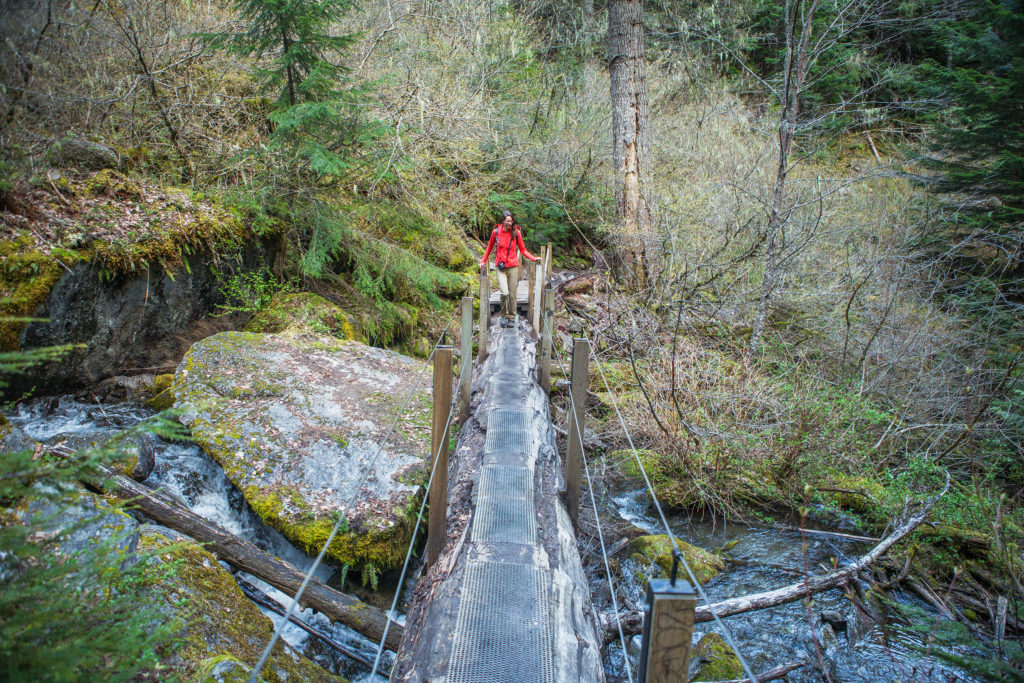
We didn’t leave the city until 3:30pm on Saturday – first we had to go stand in line for two and half hours to go vote for the french elections. It took us a couple of hours to drive to the Elk Mountain trail head, and when we got there, we were welcomed by a nice big sign indicating (amongst other rules) “No Camping”. I was so excited about the idea of camping up there, with the potential of catching a pretty epic sunset and/or sunrise over the valley, I hadn’t thought to check whether it was actually ok or not.
Now, following the rules might make us look a bit square, but if our trip to Patagonia has taught us anything, it is the importance of such rules in the preservation and conservation of the land. And in this case, the sign clearly indicated that the mountain was home to sensitive and fragile eco-systems, which camping (and building fire, etc) would contribute to damaging. Not to mention that leaving our car un-attended over night could potentially create concerns of lost or injured hikers if a forest ranger happened to be driving by…(We’ve hiked up to the mountain since, just for the day, and it seems to be a pretty popular camping spot despite it all, so that second concern might not be a huge deal, but still…)
So with that we improvised a plan B. Reaching for our Backroad mapbook, we decided to head further east to the Lindeman Lake trail head. We had gone to Lindeman last summer, just for an afternoon, but continuing along the same trail past the lake would take us to Greendrop Lake, another more remote camping option.
It was already 6:30pm when we arrived at the trail head, but we figured we had a good two hours of daylight still, so we got going. The hike to Lindeman is only 1,7km, with some steep and technical sections, but overall fairly easy. Once we arrived at Lindeman, we walked along the lake through the camping area. Being the first sunny week-end in quite a while, the grounds were pretty busy with campers. The trail took us along the shore, and through a boulder field at the northern end of the lake, then we left Linderman behind and continued hiking deeper into the back country. We had another 4,2km to cover to get to Greendrop, which ended up taking about 2 hours. The trail was pretty technical, alternating between densely forested area, and rock-covered single track along boulder slopes, with the addition of a few stream crossings, made likely bigger at this time of year by the snow melting.
The last 1.4 km were all in trees, but there was a good foot of snow left still in that portion, which slowed us down a bit. About 700 meters from the campground, we had to take the head lamps out to finish. Thankfully the trail was very well marked with bright orange markers and ribbons every 25 meters.
We made it to the campground around 9:30pm. It was completely dark by then. There were two groups of campers already set up, with nice fires going (they had likely logged their own firewood all the way up, as everything around was way too wet to burn). We hadn’t planned on making any fire, but even with the slightly below zero temperature of the night, we managed to stay cozy in our puffies and sleeping bags.
Dinner was quick to make – the folks at Good to Go had sent us a selection of their dehydrated meals to try, and it turned out to be quite tasty (we had the thai curry that night, and their granola and oatmeal for breakfast the next day).
The next morning we took our time having breakfast and checking out the lake in daylight – it was still mainly covered in snow and ice. Then we headed back down to Lindeman. With the sun out, the trail was really beautiful, shafts of light coming through the trees and creating bright rims around the moss-covered boulders – all in classic PNW fashion.
While we had seen no one on the way up, we passed quite a few people taking the day hike to Greendrop. It took us much less time to arrive back to Lindeman, and we decided to take a break on the northern end of the lake, rather than join the crowds along the western shore. After a quick bite, we walked the remaining few kilometres back along the lake and down to the parking lot. Lindeman is a very popular destination – as we had found out last summer, and no wonder. The turquoise colour of its water, surrounded by snow-capped mountains make it probably one of the most accessible, scenic places in the area.
We reached the parking lot at 2pm, perfect timing to dodge the growing crowds of afternoon hikers. Before heading back to Vancouver, we couldn’t leave Chilliwack without stopping by I Fly for Pie, the diner-style restaurant located at the Chilliwack airport, famous for its decadent pies…

On the 5th day of our trek, our we woke-up to rain – we had been pretty lucky so far with the weather, so it wasn’t surprising that it eventually caught up with us. There was quite a bit of activity in the communal hut, with groups trying to pack their gear away from the rain and preparing themselves for a wet hike. We took our time having breakfast and let the majority of hikers leave ahead of us. There were only 2 more people left in the hut when we finally headed out.
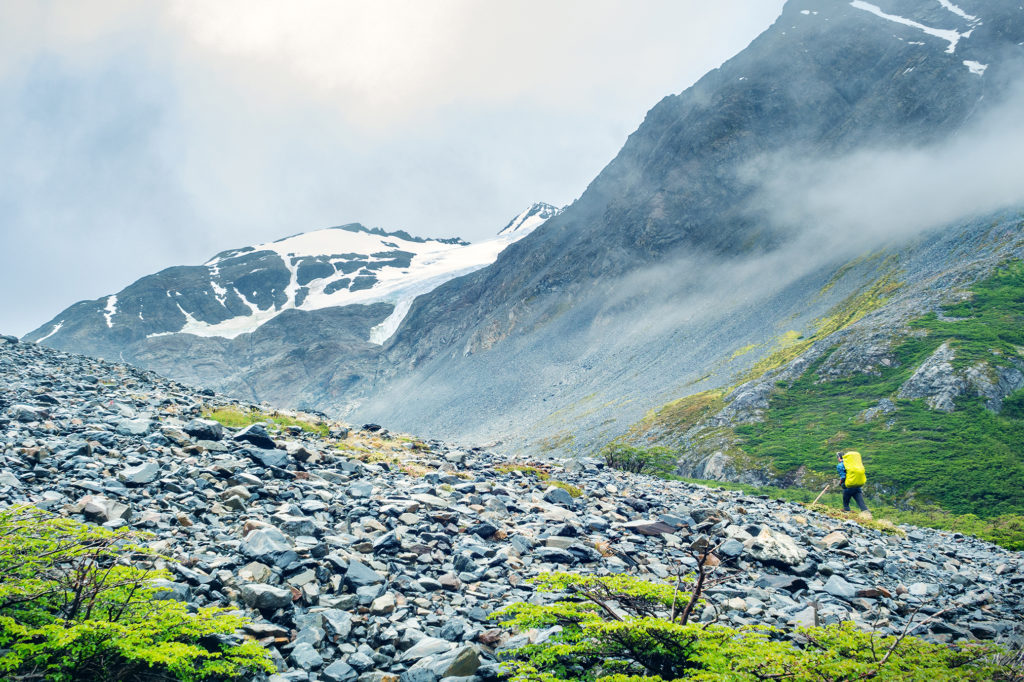
The beginning of the trail what somewhat reminiscent of climbing the Grouse Grind or BCMC in North Vancouver, single track forest trail with roots and rocks and complete with copious amount of mud. The rain had actually almost stopped as soon as we left the camp, so at least we stayed dry.
Eventually we left the tree line and started going up a steep scree. Looking up we could see pretty far to the top of the hill, and I was so glad that we were climbing this on fresh legs and not after 10km, like we would have had to if we had stayed at the Dickson campground.
I actually very much enjoyed the climb. Although we started in the clouds, the sky was slowly clearing up and we could see pretty clearly the mountain range around us as well as below, the valley we had just come from.
We thought that Jen had gotten an early start from Los Perros but turns out she had left after us, and caught up with us on the way to the top, so we finished the climb more or less together.

We had been warned against bad weather and really strong winds when going through the John Gardner pass. If the weather is too bad, rangers will actually close the pass and you’ll have to wait until the next day to cross – there was indeed a ranger stationed on the way to the top who I guess would be there the whole day making sure crossing conditions were good and enforcing a cut off after a certain time of the day. But once again, we lucked-out. As we stepped through the pass, the view on the other side was pretty incredible.
We found ourselves looking down at a sea of clouds, with sun hitting the summits of the mountains marking the edge of the Hielo Sur (the great Southern Ice Shelf), from which Glacier Grey flows down. It was a breath-taking view, of a whole different scale than the iconic “Torres”. And to make it even more exceptional, there wasn’t any wind, not even a breeze. We stayed at the top for a bit, taking in the view and as we did, the clouds below were starting the dissipate, revealing the subtle shades and relief of the glacier.
We then started to descend on the other side. We still had a bit of a ways to go to the Grey campsite, where we were going to spend our last night in the park. After climbing down the scree and moraine, with incredible views of the Glacier all along, we were back in the forest for what turned out to be one of the most challenging sections of the trek, due to the very slippery and muddy trail, and the weight of our bags on a steep downhill. Once again we had planned lunch ahead and cooked noodles at camp that morning to take with us. So when we started to feel low on energy we were able to just stop on the side of the trail and eat.
There was one more campground after the pass and before Gray, Campamento Paso. We didn’t stop there long, as it was already a bit crowded with the hikers from Los Perros who had left before us, and instead just kept moving. The sign at Paso indicated we had 10km to go to Grey campground, which the map said would take about 5 hours (it seemed a bit much on paper, but it did take us close to 4 hours).
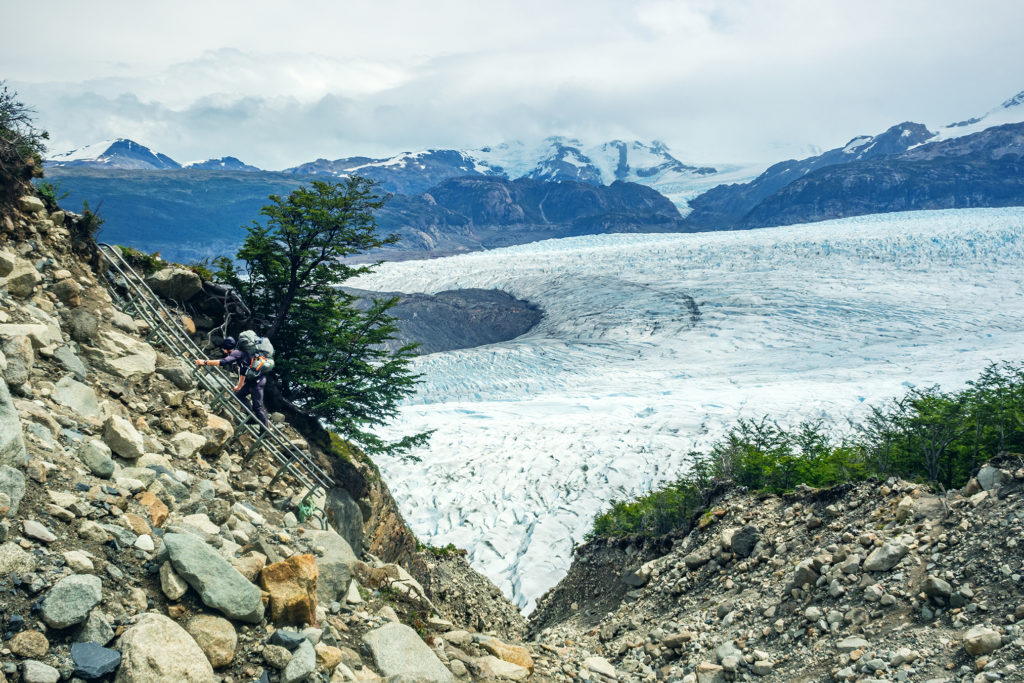
The trail continued to be pretty steep all the way down to Refugio Grey (we were going from 1200 meters to more or less sea level). There were a few cool suspension bridges along the way, and a stream crossing that involved a somewhat sketchy steel ladder anchored to the side of the small canyon.
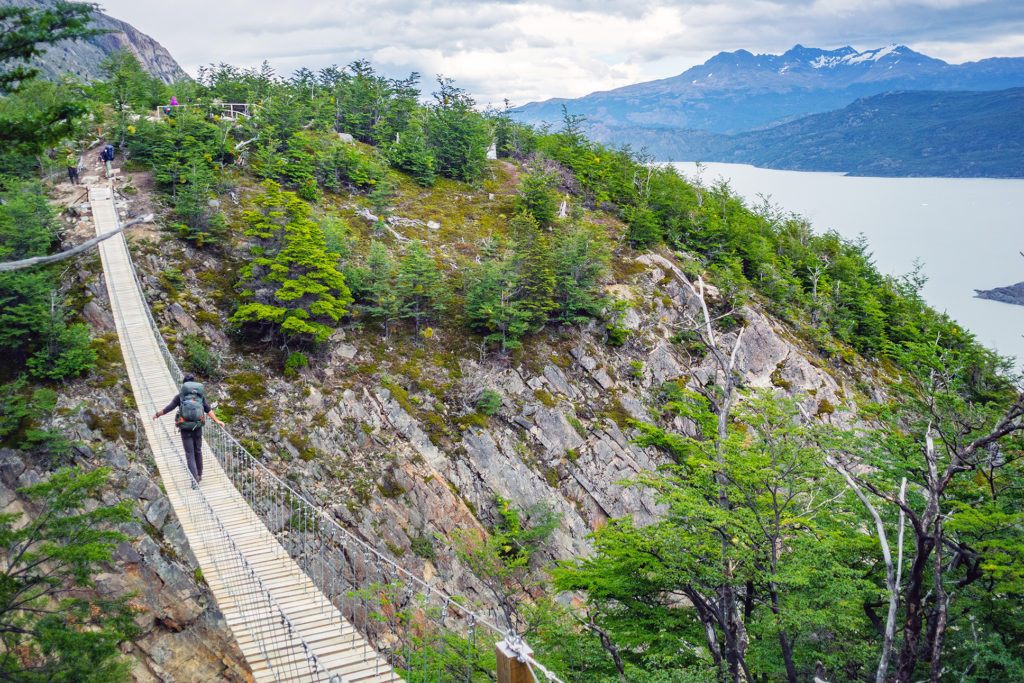
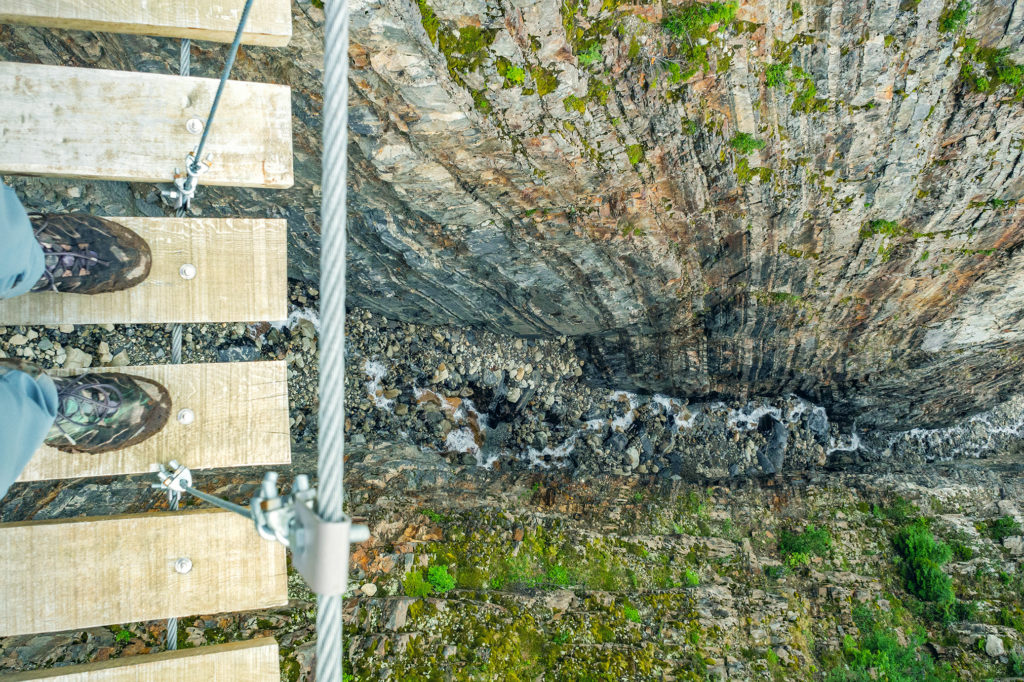

Eventually, the ridge trail took us past the edge of the glacier and along the lake. We had left Los Perros around 8:50am and after 17km we reached Grey campsite just before 5pm. Grey is a pretty big campground, as it hosts hikers finishing the full circuit, as well as “W” hikers coming counter-clockwise from Refugio Paine Grande (where we had gotten off the ferry a few days earlier).
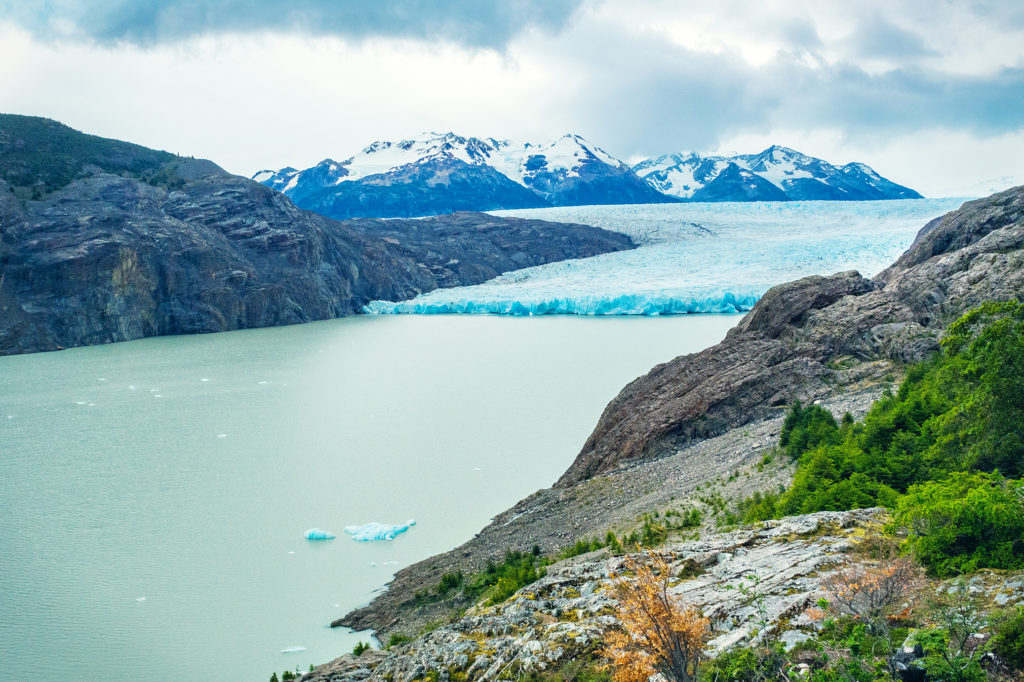

After checking in, we waited for the camp store to open and grabbed pretty much every flavor of our now favorite pound cake, as well as additional snacks to replenish our calories.
The campground advertised that showers would be heated between 7pm and 10pm. I was within the first ones in line at 7pm – which might have been a mistake, because the water was not heated yet when my turn came – unless, and I have a feeling that’s the real reason, “heated” meant warmed up from glacier temperature to room temperature…
The next day was our final day in the park. We had 11km to hike to Paine Grande to catch the ferry around 11:30am, and then the bus back to Puerto Natales. This final stretch offered more views of the lake, with the glacier becoming smaller and smaller behind us.
We had already noticed that signs along the trail were approximate at best when it came to distances, but on that day we came across the most striking example of it. The first sign we reached that morning indicated that we had hiked 6km since Refugio Grey, and had 4 more kilometers to go until Paine Grande. At that point, Brice’s watch actually read 4.8km. 4km later, we reached another sign, which now indicated we had hiked 7.5 km since Grey, and had 3.5 more to go to Paine Grande. Yup, that first sign was pretty much off by about 7km, which is a bit much on a total distance of 11. So bottom line is, signs in Torres are not to be trusted.
We reached Paine Grande, on the shore of Lago Pehoe, at 10:45, with ample time to spare before the ferry arrived.
There is (or there was) an additional section of trail that you can tag onto the the rest of the circuit (which turns it into the “Q” circuit) and continues from Paine Grande to the Administration office. From there you can get on a bus back to Puerto Natales, without having to take the ferry. It seemed like in the past there might have been a campsite halfway along that section, but apparently it was closed between November and March. I had contemplated at some point staying an additional night in the park, and doing the full Q, but since the option of camping on the way to Administration wasn’t available at the time, we decided to stick to our initial plan and return to Puerto Natales that afternoon via the ferry. We did however put our bags down by the ferry dock and with that weight off, literally flew up the hill along that trail to get a higher vantage point on Lago Pehoe and all the Torres behind. The perfect vista to end our 6-day trek.
On the boat ride back, we were able to take in one last time the view of the iconic mountain range, highlighted by the turquoise water of the lake.
Back in Puerto Natales, we headed straight to Yellow Plum, a small campground near the center of town that we had noticed when we came through the first time around. We had been pretty impressed by the smart layout of the place and had decided to try and spend the night there rather than in a hostel, on our way back from Torres. There were 3 other tents in the small camping area. They belonged to an Italian couple, who was biking through Patagonia and had started in Ushuaia, an American who lived and taught English in Brazil and was traveling during the summer school break, and a Chilean family of four. We made each other’s acquaintance around the fire pit and later over diner, that we were able to prepare in the outdoor kitchen. The owner’s family also came for diner and to ring in the new year and at 12am, every one was outside celebrating and hugging each other. I asked Carlos (the owner) what were some of the Chilean traditions on New Year’s eve and he told me that one of them was to take a suitcase or a bag and go around the block, to bring more travel in the new year. That was easy enough for us to do and shortly after 12am, we took a stroll around the block with our (empty) backpacks on.
The next day we left Puerto Natales in the afternoon, and took a bus to Punta Arenas. When we originally booked our flights, Punta Arenas seemed to be the best option near Torres to fly back to Santiago (although it might be possible to fly out of Puerto Natales). When planning the trek in Torres, I had factored in an extra day so that we had a buffer in case we were forced to stay in the park longer, and to avoid the risk of missing our flight back to Santiago (and as a result, Vancouver). Since we didn’t need that extra day in the park, we spent it in Punta Arenas instead. We arrived in the evening on Jan 1st. Our Airbnb host, Miguel, came to pick us up at the airport, and took us on a quick drive around the center of the city.
The next day our flight wasn’t until 5pm, so we spend part of the day walking around town and along the seaside, before heading to the airport. Punta Arenas is located on the straight of Magellan, which connects the Pacific and Atlantic ocean. It was the southern most place we had ever been.

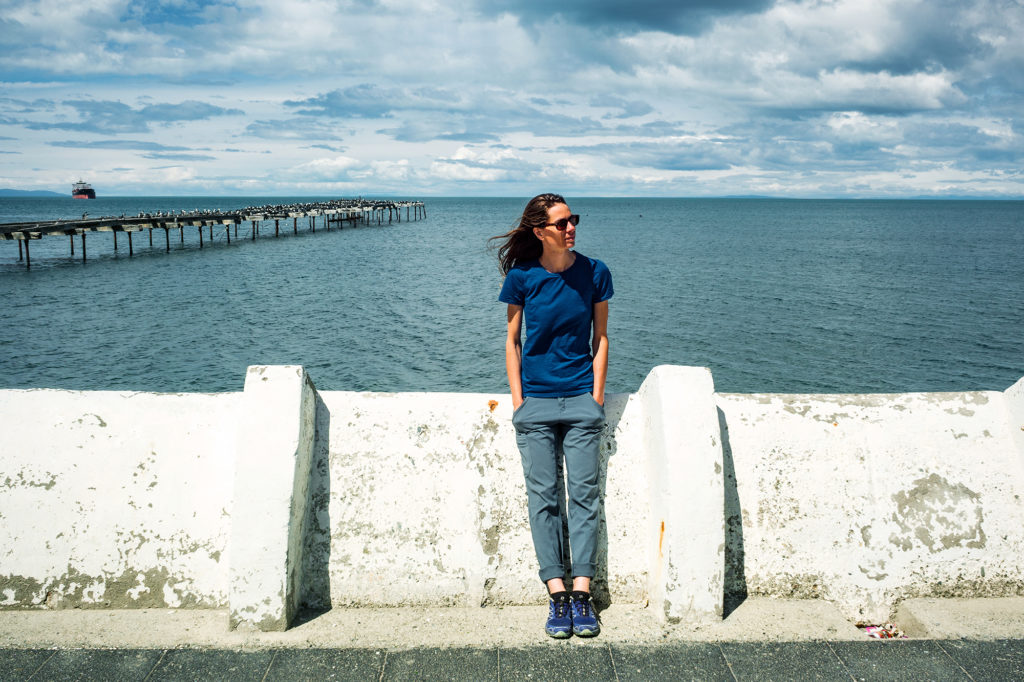
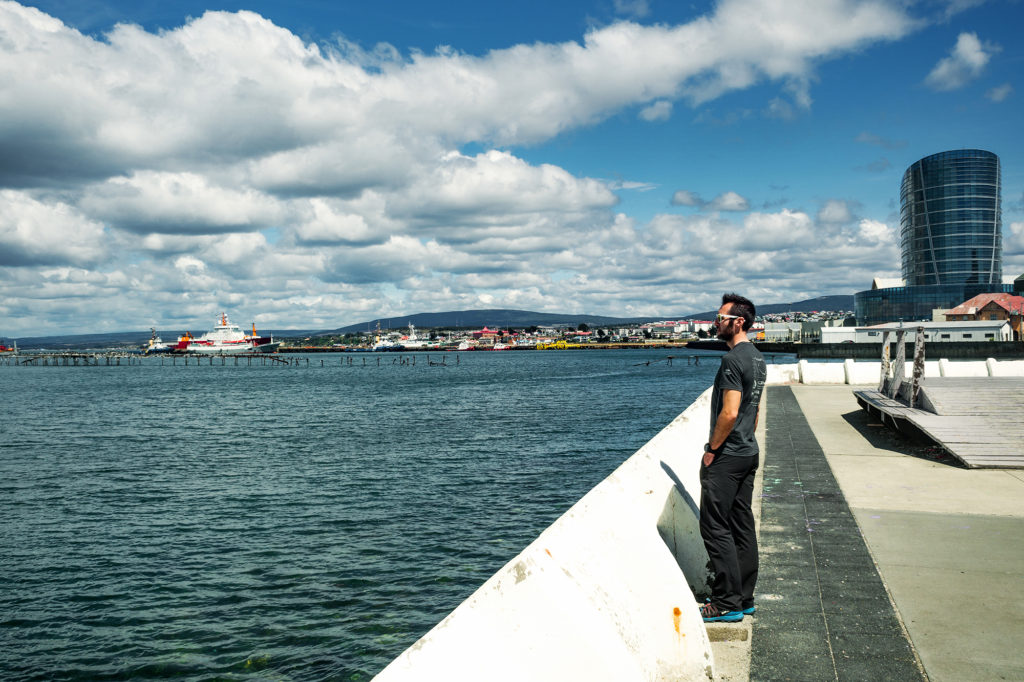
The flight from Punta Arenas to Santiago was about 4 hours. Between Santiago and Vancouver, we had a 12hour lay-over in Mexico city – but at that point we didn’t really feel like immersing ourselves in a city of 20 million people. So instead we headed to the Aero Mexico executive lounge, and for about $25 per person, we were able to spend the day enjoying comfortable couches and unlimited food and beverages, until it was time to board our flight…
And then just like that, it was time to go home…
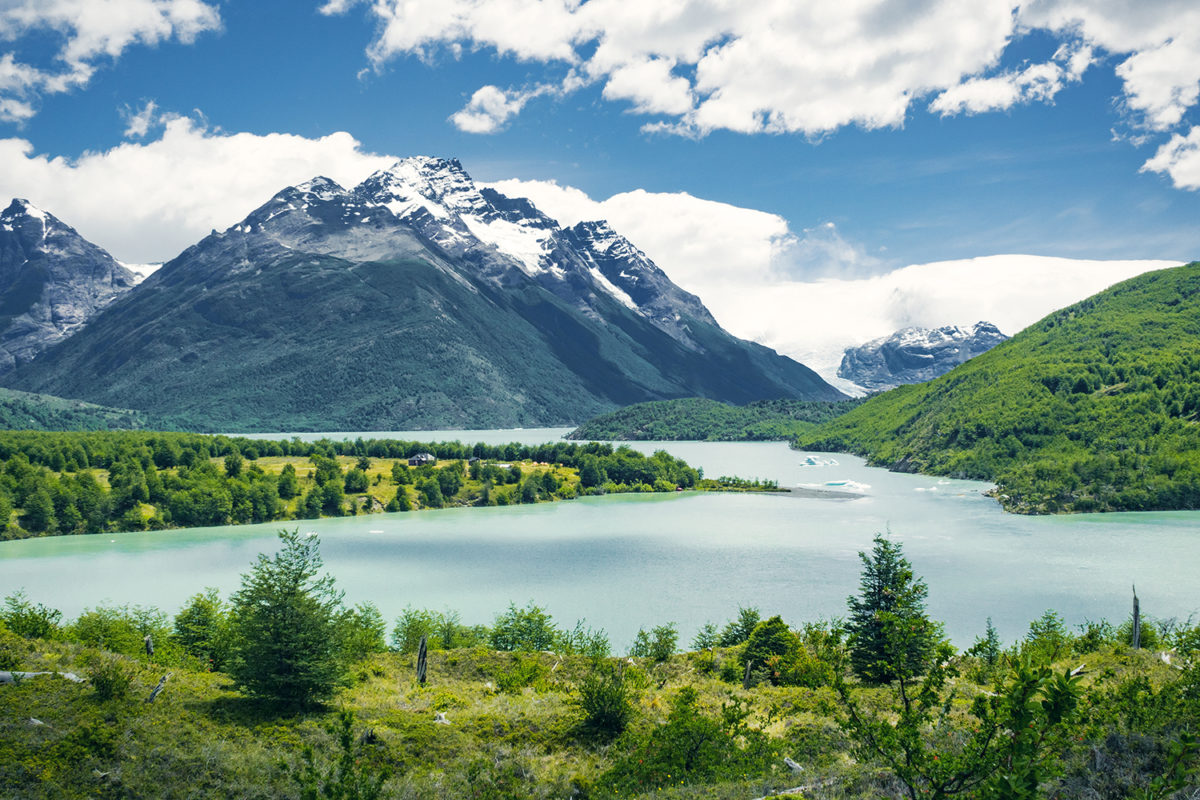
The Torre campsite is only about an hour away from Laguna Torres, so in his itinerary, Adventure Alan suggested to take a second trip up at dawn, in order to get that stunning sunrise view of the peaks. Well, that time of year, dawn was just before 4am. We did set up the alarm, but as it went off in the morning, we also heard the rain pounding on our tent, and decided it was a no-go. We could also hear quite a few campers around us getting up and walking around with their headlamps, ready to head up there. Factoring all of this, it was unlikely we would get a similar experience than the one we had the night before, so we went back to sleep for a couple of hours.
We first had to hike down along the eastern side of the “W” back through Chileno Lodge and down to Las Torres Hotel. At the Lodge, we actually made a quick stop to take advantage of the hot showers – most hikers who had stayed there overnight had already left, so we didn’t have to wait in line.
Then we hiked all the way down to the hotel, and had lunch outside of the eastern most refuge, which was near the trail head for the second half of the trip, the backside of the O circuit.
There were no other check points between the Hotel and the Serón campsite. The trail was different from the previous day, since we were now down closer to sea level. Leaving the mountains behind for a bit, we went through very pastur-esque sceneries, with open fields and flatter, wooded area, some of them still showing the signs of wild fires.
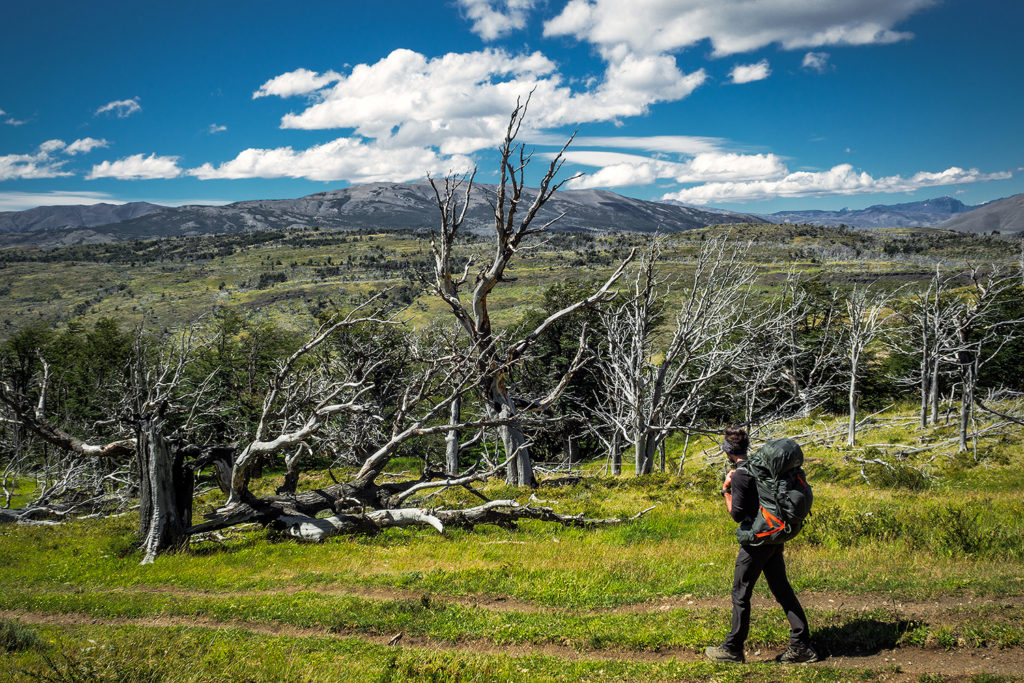


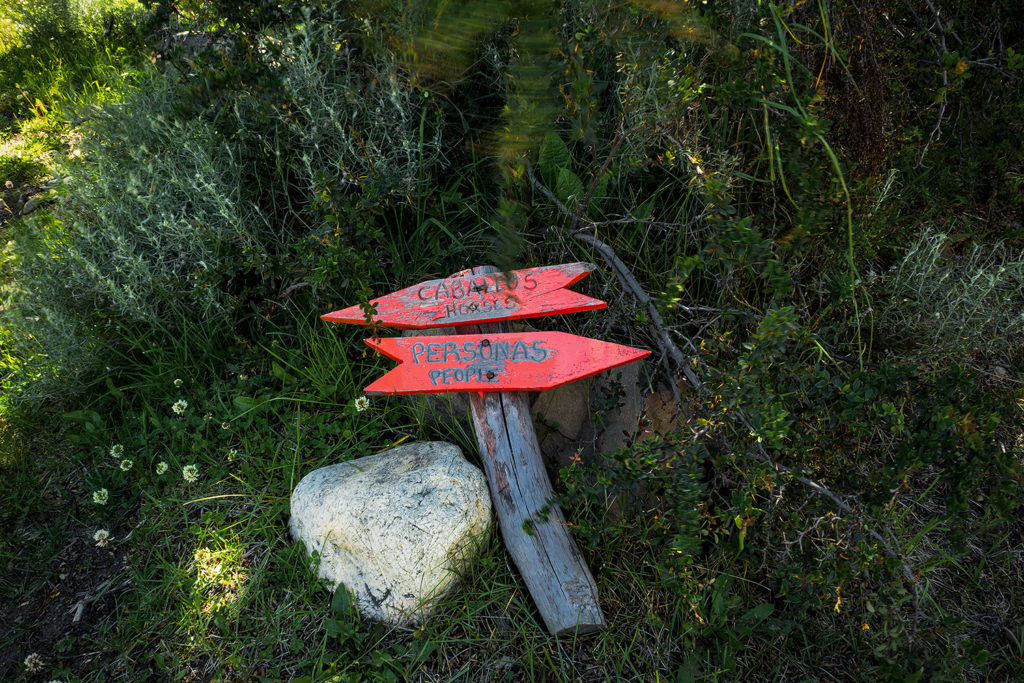
We also got some really stunning views of the valley along Rio Paine. There was a good amount of horses on the trail, which was wider and offered the ability to take horse-back riding tours. The wind hit us pretty hard in some of the more open areas while descending into the valley, and slowed us down a bit. Eventually though it calmed down as we got to fields after fields of wild flowers.
Once we got to the bottom of the valley and under the cover of the trees, we took a break for a snack. We knew we were getting pretty close to the campground at that point, but as I mentioned before, signs in the park were approximate at best, and distances indicated on them rarely accurate for some reason. I thought we only had another kilometer to go but as we kept moving along in those wide open fields, I still couldn’t see a campsite in the distance. We past a row of tree and at that point I was reaching the mental state of “ok we should have arrived by now”. When you get to that point in your mind, it doesn’t matter how much energy you still have in store, you’re just about done. So I was hoping the campsite was just behind the tree line, but then we were on the other side and it was another huge open field with no sight of man-made structures. We kept on walking for another 20 minutes and eventually, after a few more fields and tree lines, we arrived at the camp. I knew part of my feeling tired had a lot to do with having mentally decided a couple of km back that I had enough of walking for the day. I knew that I could have walked a lot longer if needed, but I had hit that mental block. It’s probably one of my biggest barriers when trying to challenge myself, to not go to that mental place of “this is too hard, I can’t”, and even though I did go there briefly that day, I was still mindful of not vocalizing it (meaning, not complaining out-loud like a 5 year old), as that really would not have been conducive to any sort of positive atmosphere. 😛
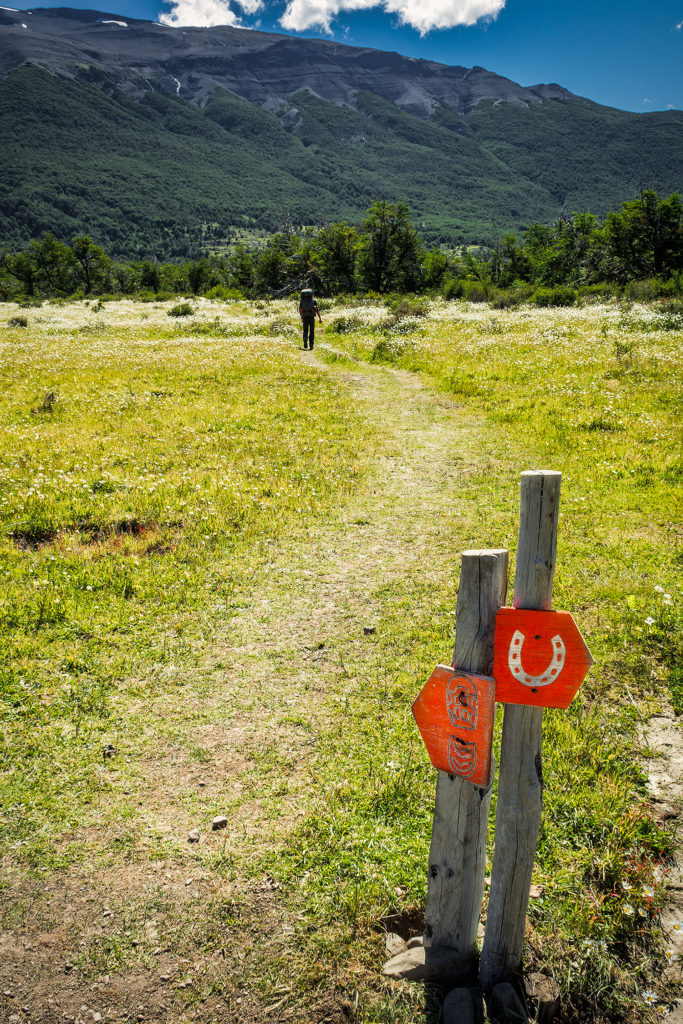
So I just let Brice get ahead of me a bit and kept on walking, all the while cursing in my head about stupid walking with stupid heavy backpack and stupid signs that gave the stupid wrong distance and stupid wind…I know, it’s ugly… But I’ve set out to give a pretty accurate account of our trip, the good and the bad, and frankly, it was pretty much good all the time except for that day when I thought I would never stop walking and it was just the worse…
I have to give props to Brice, who on the other hand, is probably one of the strongest person I know when it comes to getting past (and even ignoring) that mental block – not that this was that challenging to him anyways, but having had the opportunity to watch him challenge himself on ultra races in the past year, and always keeping a smile on his face and never complaining, even when it hurt, that was definitely an inspiration I took with me on this trek and tried to channel that positive attitude throughout the journey…Hopefully I did ok – but that’s more for him to say.
So we got to camp and I put my bag down and decided I just needed a minute, so Brice went to check us in and came back carrying a bottle of wine he’d gotten from the small refugio store, which right there made everything better.
The campsite was an open field, much more exposed to the wind than the previous ones we had seen so far, but our tent stood up to the task once again and we slept really well – it was even a bit warmer since we were lower in elevation.
The following day was going to be our longest day in terms of distance, as we had to cover about 30 km from Serón to Los Perros (and I was mentally prepared for it :P). There was another campground on the way, Dickson, that we could have stayed at, but then it would have meant adding 10 more km and an extra 600m of gain on the day we were going over the John Gardner pass, which was the highest point in the whole trek (1200m). So instead we followed Alan’s suggestion and went all the way to Los Perros, the last campground before the pass.
At breakfast, we talked to two hikers who happened to be porters, hired by tourists to carry their backpacks for them. For some reason we hadn’t even imagined that it could be a thing, not here anyway. But I guess it was, and it left us a bit perplexed about the sort of people who would set out to do a trip like this, but only embrace the enjoyable part and none of the challenges. When you know that you can buy every meal at the campsites, and you can rent all your camping equipment as well, to the point where your tent would be already set up and waiting for you when you arrive, what is there still left to carry really, other than a few pieces of clothing and a camera….But maybe I’m passing a negative judgment here and there could be very good reasons for this service to exist…
The beginning of the trail took us through more fields of wild flowers, then we hit a pretty steep hill (that the porters at breakfast had warned us about ;P), which took us a good hour to climb, until we started walking along a ridge just above the river.
It was once again beautiful, and another, different view we hadn’t seen yet. After about 9km we arrived at the Coirón Rangers station and stopped for lunch. Since we weren’t allowed to cook in the park (other than in designated area), but most of our food involved some sort of heating, I had thought of pre-cooking some instant noodles in the morning. We drank the broth at breakfast to avoid any leaking in the bag, but then packed our noodles up so we can have them later. Add a can of tuna to this and it was a pretty delicious lunch, which required no additional cooking, therefore good time saving. This proved to be a good method to guarantee a sustainable lunch if we had to stop somewhere along the trail where we couldn’t use our stove.
When we arrived at the check point, the ranger asked us how far we were going that day. We said all the way to Los Perros. He looked at his watch and said “don’t take too much time, you need to get to Dickson by 3pm otherwise they won’t let you continue on”.
Dickson was another 10-11 km away, and it was almost 12:30pm. The map said that it would take about 3hours to get there, and although it had been pretty accurate in the last couple of days, we thought we could probably get there faster. That section of the trek was also the flattest of the whole circuit, which definitely played in hour favor. So at 1:00pm, with our belly full of noodles and our energy restored, we headed out at a pretty steady pace (while still taking a moment to snap a picture here and there). The approach of Dickson was quite stunning, as we walked along a ridge overlooking Dickson lake and the campground, and we could see little pieces of detached ice floating around in it.
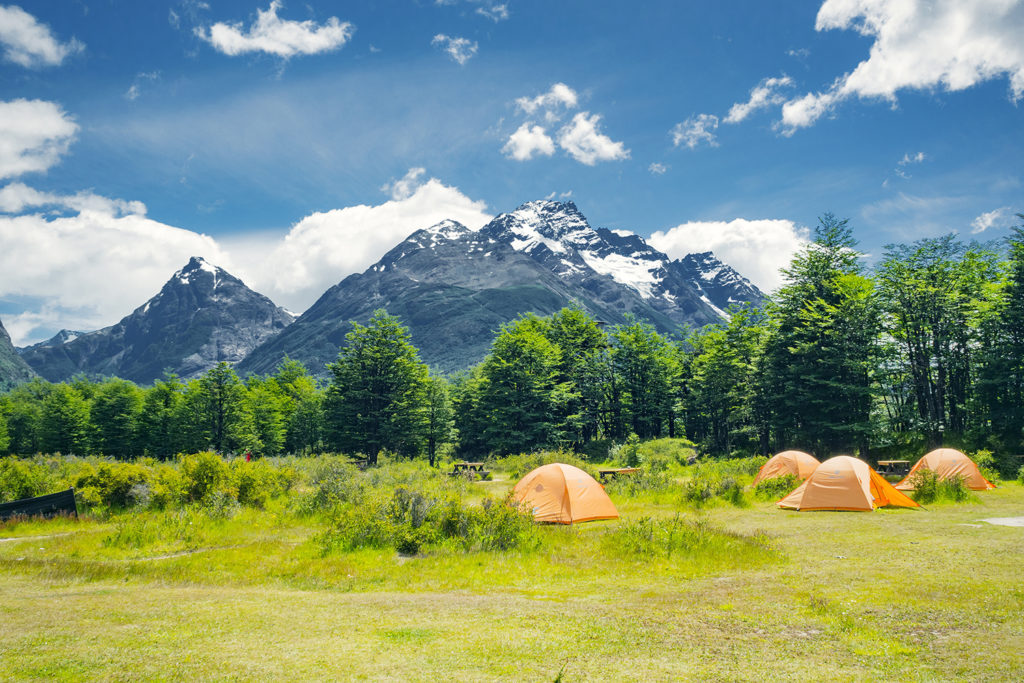
We arrived at Dickson at 2:30, only 1h30 after leaving Coirón, on a section that was estimated to be about 3hours. Pretty good!
The rangers there told us that the cut off for leaving from Dickson was 4pm (and not 3pm), so we had plenty of time and decided to take a break and enjoy our surroundings a bit. But first we hit the little shop for additional food, as the stock we had purchased in Puerto Natales were pretty much gone. The shop was small but had quite a bit to chose from, including different kinds of soups and instant noodles. We grabbed a couple packs of cookies and as we were about to pay I also pointed to a “Buddin” (that’s the brand name) pound cake that seemed to be calling out to me. We made a “gouter” of pound cake and coffee and it became our new favorite snack for the rest of the trip (especially after we found out it actually came in different flavors such as chocolate or orange).
We hung out in Dickson a little bit, taking a walk on the lake shore and just enjoying not having a backpack on. But then we still had another 10ish km to go, with 400m of elevation, and our legs weren’t so fresh anymore, so just before 4pm we put the packs back on and continued on.
The next stretch took us into the forest for a fair bit, and eventually up to the base of the Los Perros Glacier. Once again we got a bit confused by the signs indication of kms and what our GPS watches where showing, and after looking around for a campground at the base of the glacier, we found it another 1km further, in the forest.

Los Perros was a bit more crowded than the previous campgrounds, but we did appreciate having a full hut (with four walls and a door) to have diner and breakfast in, rather than a small 3-wall shelter like in previous campgrounds.
At night, we chatted some more with Jen, who had made it to the campground just before us. We were all pretty beat after a long day and went to bed early. The next day would be another exciting one, with the crossing of the infamous John Gardner Pass.
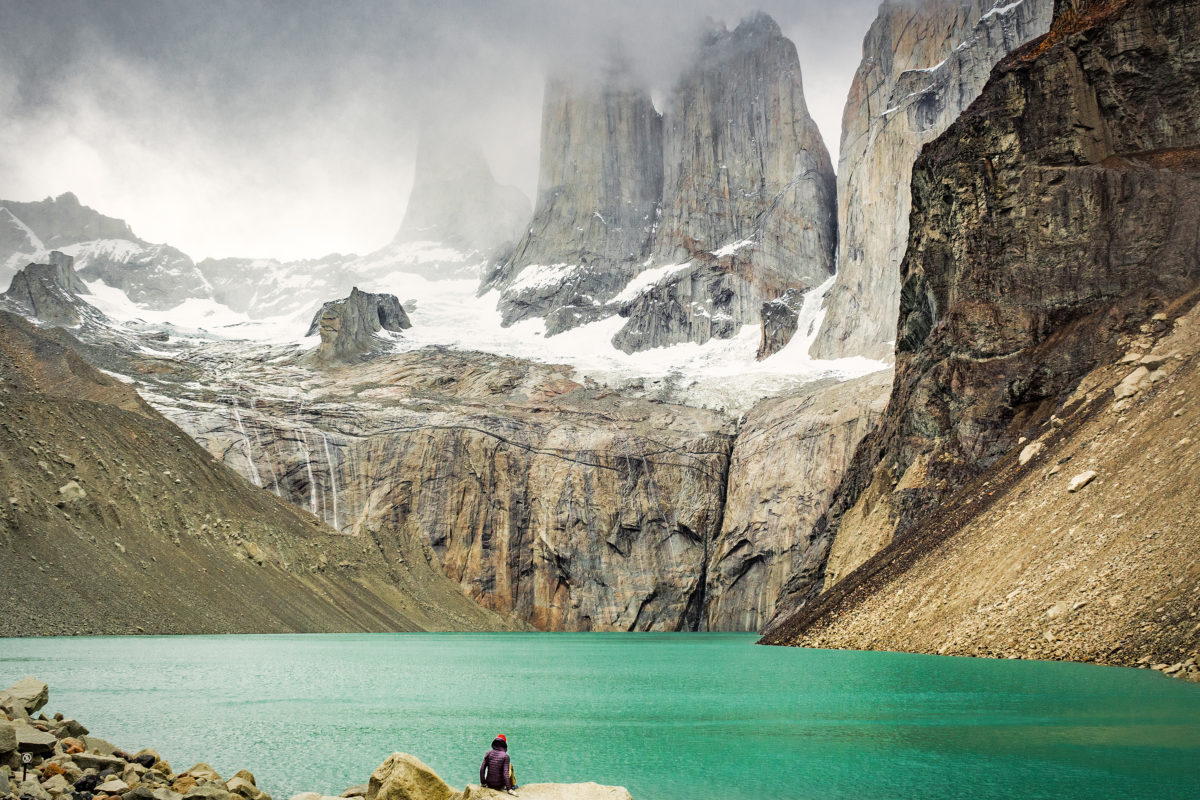
On the morning of Dec 26, we got on the bus at 7am. From Puerto Natales, it took about 2 hours to get to the park entrance at Laguna Amalga. Everybody had to get out of the bus to go into the ticket office. We filled out a form with our info, and how many days we were going to spend in the park, then paid the entrance fee, and finally we had to watch a short video detailing all the rules and guidelines. Due to the growing popularity of the park, they had to enforce some pretty strict rules about where people can eat and sleep, in order to preserve the land and avoid major damages caused by human impact.
From the entrance, shuttles took people to the hotel on the eastern side of the park, the one closest to the iconic Torres. The rest of us got back on the bus and drove to the second stop, were we would board a ferry to cross Lago Pehoé and reach the western side of the “W” portion of the trek.
The ferry crossing was a pretty interesting experience. The boat was fairly small, and, as people in front of us boarded, we could tell that not everyone that was waiting on the dock would fit. In fact, we had to let the first boat go and wait for it to come back to get the rest of the hikers (which delayed us by over an hour). That’s right, there is only one boat that crosses back and forth. This was pretty telling of the incredibly growing popularity that the park has experienced in the last few years, and how the infrastructure hasn’t quite been upgraded to accommodate it – and nor do they necessarily want to. Once on the boat, all the backpacks were piled up near the front of the cabin. Then one of the crew stood behind a little counter in the back, and people lined up to pay for the crossing – in cash only of course. They only checked if you had paid for your ticket as you exited the ferry. Not the most efficient process, but probably one that worked fine back when boats weren’t filled up to capacity on every crossing. A few people who were going on day trips in the park got quite annoyed by the time they wasted having to wait for the boat to come back, but Brice and I were pretty unfazed by it, having now experienced a number of ways that, from our North American perspective, optimal efficiency was not a major concern in Chile – and it was totally ok.
After driving for days on isolated roads and barely seeing anyone, it was a bit jarring to find ourselves on a boat full of tourists. As soon as we got off the boat, we headed towards the start of the trail and got to walking. It was almost 2pm by then, and we only had about 8 km to cover until our first campground – so a pretty chill day to begin with.
The wind on the shores of the lake was pretty strong though, and together with getting used to hiking with a heavy pack, it made the first few kilometers a bit more challenging that I would have thought. The weather was otherwise on our side, with sunshine for most of the way.
The map we were given upon purchasing our ticket had loads of useful information, including elevation profile (I love looking at that stuff!) and estimated travel times. Hiking without a pack, we probably would have been a bit faster than the times on the map, but with extra weight, those ended up being pretty spot on – and a whole lot more reliable than all the signs put up in the park – but more on that later.
Once we arrived at the campsite, Campo Italiano, we first had to check in with the rangers. They checked that we indeed had a reservation for the campground, then we were able to chose a spot to set up our tent. After that, we left all our gear in the tent, changed from hiking to running shoes and hiked up the Frances Valley trail for a bit. We only went as far as the Frances Look-out (about 2 hours return) but the trail went on much longer for a possible 5 hour return trip from the campground. We had a whole lot more hiking ahead of us in the next few day, and we were in bed by 8pm.
The next day we hiked from Campo Italiano to Campo Torre, about ¾ up Valle Ascencio. The trail offered some beautiful views of the Nordenskjold Lake, then after the short cut to Chileno junction, we started going up the valley, along the ridge of a canyon. We again experienced some pretty insane wind. At the highest point of the ridge, just as it curved around the side of the mountain, the wind was so strong you had to really push through to move forward. Brice got blown 180 degrees on his feet while filming, and I’m pretty sure I swallowed some gravel that was being blown in my face.
We stopped every couple of hours for a quick snack, making sure to consume the proper amount of calories to keep us going. Around 3pm we reached the Chileno lodge and stopped for a longer coffee and cookie break. We also started chatting with Jen, a solo hiker who was doing the full circuit like us, and had arrived on the same day – although we didn’t hike at the same pace, we ended up seeing her quite a bit along the way, as she too was following Adventure Alan’s recommendation. It was nice actually to see a familiar face on a daily basis and be able to share our impressions of the journey with her.
After Chileno, we had another 1.5 hour of climbing before reaching Campo Torre – the sign outside of the lodge said we were 1,2km to the campground, but it ended up being much closer to 3km (that was our first hint that signage in the park was NOT to be trusted).
Once we arrived in Campo Torre, we repeated the previous night’s cycle of putting our tent up, then leaving our gear behind to hike higher up. This time we were hiking to the iconic Torres, the ones that you see in every photo of the park ever posted on social media. The weather had become overcast at that point, so we weren’t sure we were going to see much, but we decided to give it a go anyways. The hike up was pretty steep and we were glad we were able to leave our packs behind. After a section in the trees, the last few hundred meters were up and along a rocky scramble. And finally there we were, inside the postcard. The iconic towers themselves were somewhat obstructed by fog, but the view wasn’t any less impressive, especially with the turquoise blue water underneath. And best of all, we were the only ones there.
Where crowds of hundreds had likely been standing earlier in the day, taking turn to get their Instagram pic on a rock by the water, now there were only us. It was really special, and I’m so glad we went up that evening rather than the next morning, as we would have had a much different experience for sure. It was sprinkling a bit so we found cover against a large rock with a bit of overhang, and just hung out there for a bit, taking in the serenity and quiet of the place.
That view was in a sense – as probably for most of the people who now come this far to see it – the starting point of this whole trip. Images of Torres had started to pop up on my Instagram feed in the last few months and when Brice suggested Patagonia as the destination for our trip, I thought about these images right away. There’s no denying that in that sense, our trip was very much the product of the influence of social media, amongst many other things of course. But I would be lying if I didn’t admit that seeing all these beautiful images of incredible landscapes on Instagram is making me more and more want to go out there and see those landscapes in real life.
And I’m of course not the only one. There have been debates lately about the impact such images have on these places, bringing more and more attention to otherwise hidden gems that were in the past enjoyed by only a few in–the-know. What used to be desolated, wild places up until 5 or 10 years ago are now becoming tourist-central, of similar category as the Louvres or Disneyworld. We’ve experienced this even at home in BC, where crowds are now rushing to places like Joffre Lakes, and in turn posting about it online, perpetuating the cycle. To say that people only go there to get that “I was there” instashot may be a bit of an exaggeration or generalization (or at least I want to believe that it is). But the fact is, putting those places on the map, especially through beautiful photos, might be having an impact, and potentially not a good one on the environment.
But who’s to say that these natural wonders should remain a secret, that the majority of people should not be allowed to know about them or to see them with their own eyes if they want to and have the means? Then again, this is probably a very selfish way to look at it, and a “bigger picture” perspective might be to say that we should be here to serve the Earth and not the other way around, and that leaving those places untouched and their beauty un-tempered with – by not actually visiting them – should maybe be more important than our individual need to have seen and experienced them.
I won’t pretend to know the answer especially since I am no different than the rest of the crowds. The one thing I will say is that thankfully, it seemed that visitors diligently abided by the rules of the park and we never saw one piece of trash on the trail, which was a nice thing to notice.
Rain was picking up so eventually we made our way back to camp. I was glad that we saw this iconic view early on in the trek, as it meant there was more to our trip than just getting that one photo and it wasn’t going to be the grand finale (far from it actually). This way it was merely another perfect moment suspended in time, another gem among the rest of the ones we’d already collected along the way.
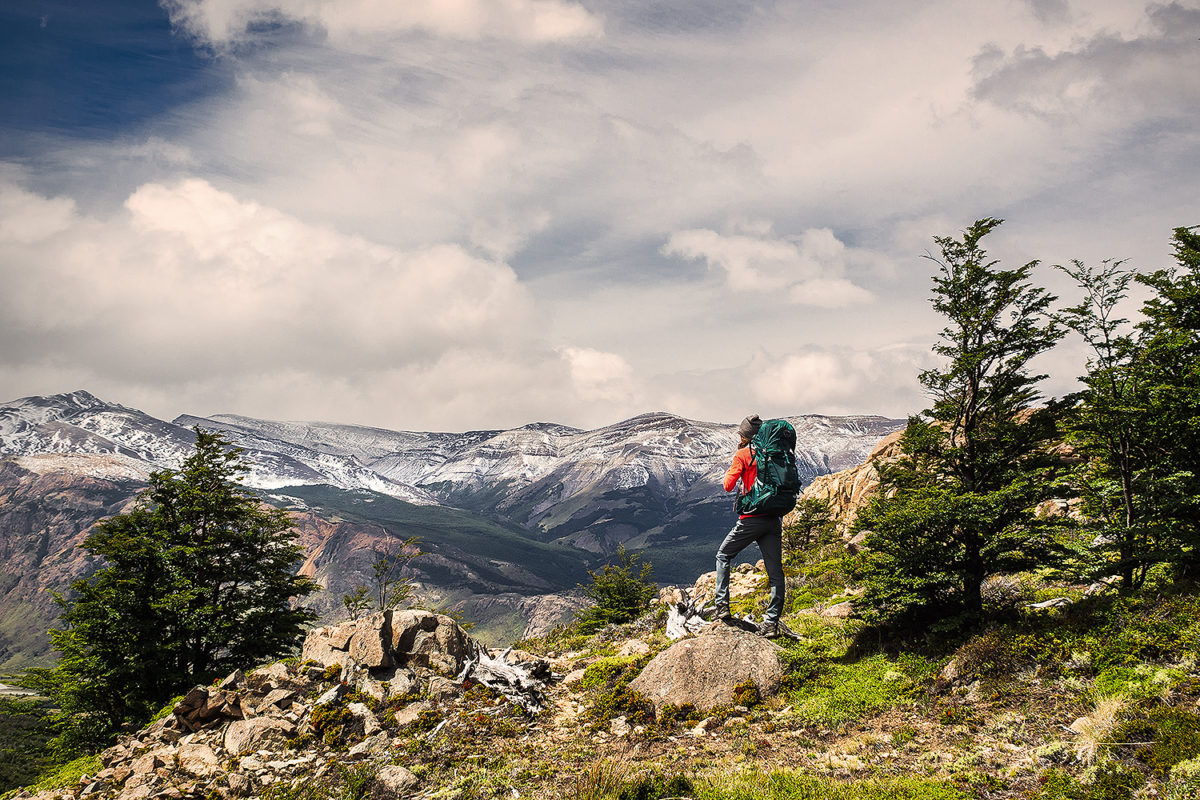
On our first morning waking up in Argentina, our fist goal was to put some gas in the tank. The only issue was that we didn’t have any Argentinian currency with us, so with most gas stations and shops accepting cash only, we had to figure out where to get some. On iOverlander someone had mentioned being able to exchange currency at a hotel. There was a small hotel in Lago Posadas, so I went in and indeed the lady behind the desk traded me USD60 worth of Argentinian pesos, without even any sort of exchange fee – I was pretty glad about it because Brice had already asked the guy at the gas station to start filling up the tank, and he was about to tell him we didn’t have any Argentinian money to pay… (ask for forgiveness, not permission, right?)
We had some pretty big distance to cover that day so we hit the road and didn’t stop very much throughout the day.
We did make one stop stop in Bajo Caracoles and found ourselves glad that we had detoured through Lago Posadas the night before. Bajo was no more than a re-fuelling stop, with one gas station, shop and small restaurant all in one place, and nothing else around it. Starting from there though, we were now on Ruta 40, and a nicely paved portion of it too. Which was a good thing because there really wasn’t much to look at on the way other than the flat endless road.
We drove about 440km that day until we reached Tres Lagos, another oasis in the desert. There was a nice campsite at the edge of town, a large fenced off yard with several “fogón” (fire pits) and enough trees to offer wind protection. Also, hot showers! And all for about 100 pesos (about 9 USD). After getting gas in the morning, and lunch, we were running low on pesos again. We tried to exchange more at the gas station this time but their rate was ridiculous. We went to the one small store in town but they didn’t have much in the way of food we needed, so instead we just got a cheap bottle of wine (which ended up being really cheap and really not good).
The next morning, we packed up camp and since we couldn’t find anything open for breakfast, we decided to drive directly to El Chaltén, the starting point for hikes in the Fitz Roy range.
El Chaltén was a bit bigger than the other towns we had driven through. It was clearly a tourist hub, but thanks to it being shoulder season, it didn’t feel that crowded to us. It felt very much like a ski resort, but people were walking around with hiking boots and big backpacks instead of skis and snowboards.
After stopping at the visitor center to get a map of the surrounding trails, we had lunch at the Waffleria. We then drove around town and must have hit all the grocery stores indicated on the map, in the search for food to take with us on our overnight trek. Eventually, we landed in THE store in town. Now, they understood what doing business in a hiking town was all about. They had a huge selection of snacks and dry goods, as well as everything “travel-sized”. From tooth paste to nuts to those little butter rectangles you get in restaurants, they had it all, in easy and light-to-carry format. They also had…cheese and saucisson (!) and at pretty decent price too, so that definitely needed to come up the mountain with us. We also found some really good bread at a panaderia just down the main street.
There were quite a few gear shops in town as well, so we also bought propane for our stove and a good pair of hiking socks for Brice, who until then had slowly but steadily been making holes in his running socks, one pair at a time since the beginning of the trip.
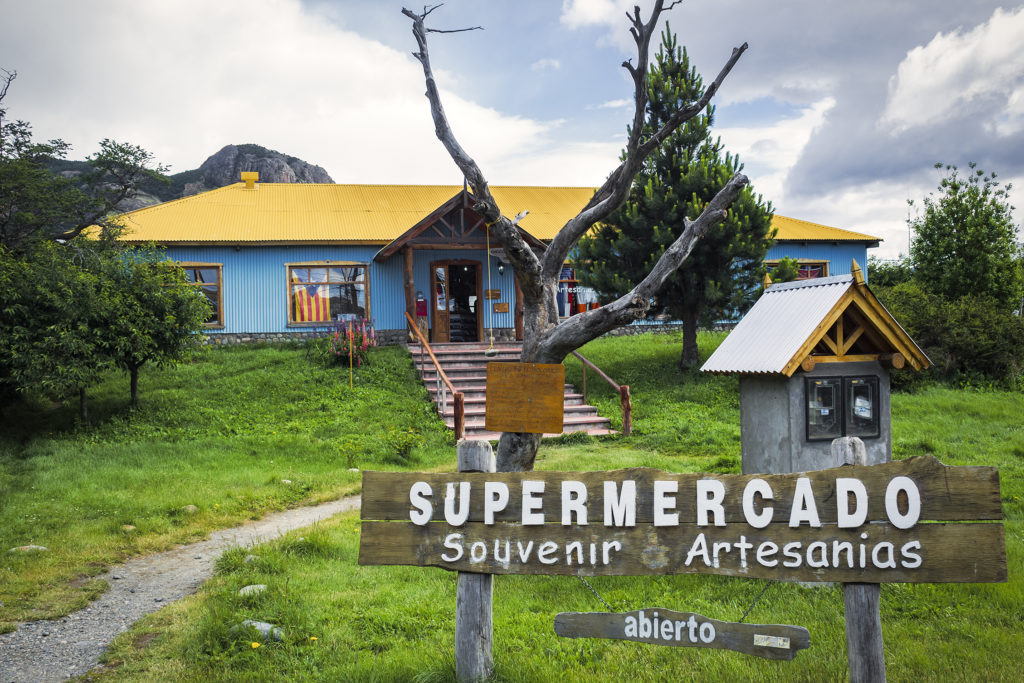
With our supplies in hand, we drove the car to the Laguna de los Tres trail head, on the northern part of town. The idea was to go up to the Laguna de los Tres sendero, then camp at Campo Poinceneau nearby. The next day we would head over to the other side of the valley and up to Laguna Torre, before heading back to town along the Laguna Torre Sendero, for a total of about 35km.
This was the perfect opportunity to do a test run with our packs and see how we would handle hiking with weight on for a day and a half. Since we still had the car, we were able to leave a lot of stuff in the trunk and only packed what we needed for the night.
The trail to Campo Poinceneau was really nice. It was sunny at first and the beginning of the trail, mainly on a ridge, offered really stunning views as we went up. On the other hand, we could see from the village that clouds were pretty thick higher up, covering up the view of Fitz Roy, and unfortunately it didn’t clear while we were going up. We arrived at Campo Poinceneau in about 2 hours, and after setting up the tent, we thought we might go take a look at the Rio Bianco Glacier, about 4km round trip from camp. But clouds were thicker still and rain started to pour so after 500 meters we retreated to our tent and decided to just hang out for the rest of the evening. The weather didn’t improve and we ended up cooking dinner inside. We had a bit of a break from pouring rain after dinner and got to see a very foggy glimpse of the “Tres” from the banks of the river just outside of the campground tree line.
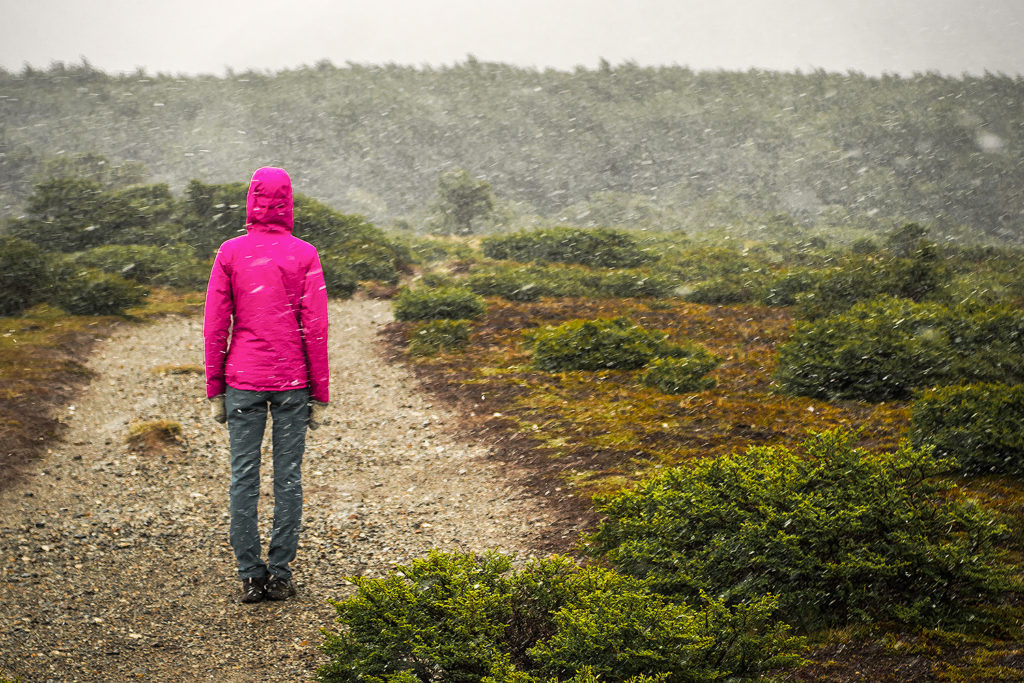
The tent was definitely put to the test that night as the down-pour continued, accompanied by strong gusts of wind. This time there was no shelter to protect us but we were delighted to see that the tent held up incredibly well, with no moisture sneaking in and firmly held down by all the extra cords that we hadn’t bothered using in previous nights when wind wasn’t an issue.
The next morning it seemed the rain had slowed down so we decided to try and hike the 2km up to Laguna de los Tres. After about 1km we had to cross a river. The river was pretty swollen from the previous night’s rain, and it took us a while to figure out a crossing point. We finally noticed an area were rocks had been placed to help in crossing, but the river was quite big and it didn’t seem possible to cross without getting our feet wet – which in this climate, is usually a bad idea.
We could also see that the peaks were completely engulfed in clouds so instead of wasting time and energy getting wet for a very unlikely chance of getting the iconic view, we decided to pack up camp and head out to the other side of the valley, were sky appeared to be clear and blue. The trail connecting the Sendero de los Tres and the Sendero Cerro Torre was a nice 8km hike going from densely forested to some open areas near a couple of lakes. It didn’t actually take long for us to leave the clouds behind and be in the sun. We barely saw anyone on that trail, except for maybe 3 or 4 people going the opposite way.
Eventually we reached the intersection with the Sendero Cerro Torre, at which point we still had 3,5km to hike up to the Laguna. We were rewarded at the top by bright blue sky and a pretty clear view of the peaks behind the lake, with just the right amount of clouds hanging on to the summits to give them a dramatic effect. We hung out there for a little while, then it was time to hike the 9km back down to town.
All together, this was a 24km day, nothing we hadn’t done before, but this was our first time hiking that distance with packs on our back. It was a good test before our 6-day trek in Torres del Payne, and a great opportunity to identify one of the major keys to a successful day of hiking: nutrition. Taking a page from the long-distance trail running book, we realized pretty quick that having enough snacks and being able to refuel calories on a regular basis would be crucial in maintaining energy (and spirit) throughout long days of backpacking. It seemed pretty obvious of course, since in general, we always do take some food with us, no matter where or how long we go hiking for. But just realizing how much more calories we were using by carrying our packs, and how much food we really needed to avoid energy crashes, was a pretty big part of this overnight trek. We got back to town and I was indeed famished. Having gone through our reserve of nuts and bars, Brice saved the day when he found in one of his pockets a pack of Hammer chocolate and hazelnut energy gel. I’m not a huge fan of gels but I have to say this one was pretty tasty (almost like Nutella), and gave me a boost when I started dragging my feet, about 4k from the end.
Since we had gone down a different trail, we ended up on the other side of town, but got to enjoy some really nice panoramas of El Chaltén. We made our way back to the car then drove to our favorite store to stock up on more goodies for the night, including of course, cheese and saucisson and wine.
We then went on the search for a campground. Once again, we avoided any options directly in town, all of them packed and lacking the privacy we wanted. Instead we turned as always to iOverlander and headed about 15km outside of town to a more isolated and quiet campground, with views of the mountains. The road there turned out to be quite scenic as well, with finally some clearer, albeit backlit views of the elusive Fitz Roy peak…
See more photos of our camping spot by click on the gallery below